In this article, we answer these questions:
- What’s your opinion about the product?
- Does the CRC Evapo-Rust really work?
- How does it work?
- How much do I need to use?
- Do I need to fully submerge the whole item, or just the rusted surfaces?
- Will it corrode the rusted metal and other non-metal components?
- How long do I need to soak the rusted metal in it?
- Do I need to sand or scrub the rusted item after soaking it in?
- Can I reuse the liquid solution?
- Is it flammable?
- Is it harmful, hazardous and toxic?
- Feedback from users in real-life applications
Disclaimer: The information compiled here is based on actual experience and diligent research. Nevertheless, it should not be treated as professional advice. As always, read the label and proceed with caution.
What’s your opinion about the product?
One Friday afternoon, our in-house product specialist, Sam C, soaked a bunch of rusted sprockets into pure Evapo-Rust solution. He took photos of his progress of what happened after soaking them (1) after two hours and (2) over the weekend.
(He also brought a pair of pliers riddled with saltwater rust, which we also covered further below.)
Quick verdict: Evapo-Rust works! Rusts gone.
Here are the rusted sprockets before soaking. As you can see, some of them are heavily rusted on the surface, while some are not:
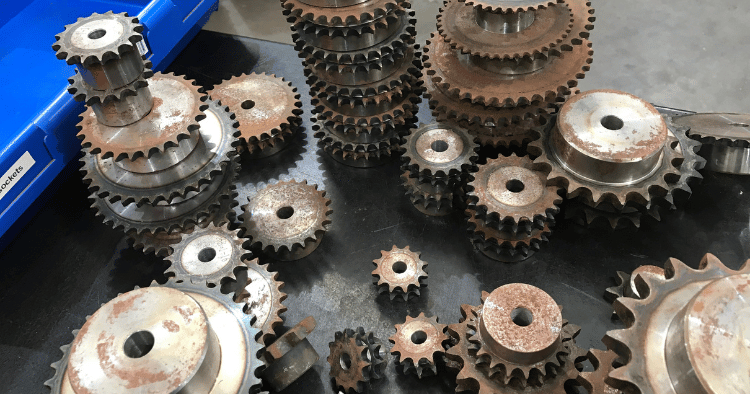
Here they are after being soaked in pure Evapo-Rust after two hours:
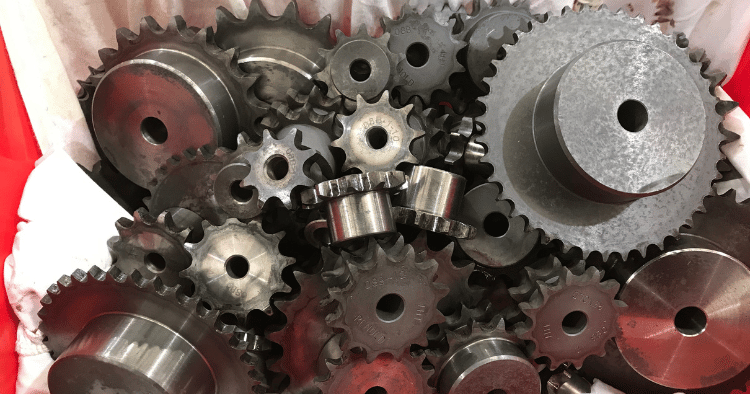
Comparison of the “untreated” (top-half) and “treated” (bottom-half) after being soaked for two hours:
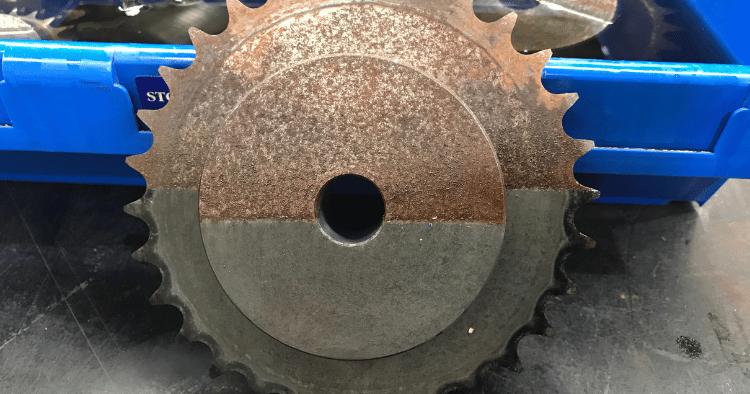
Here they are after being soaked into pure Evapo-Rust over the weekend:
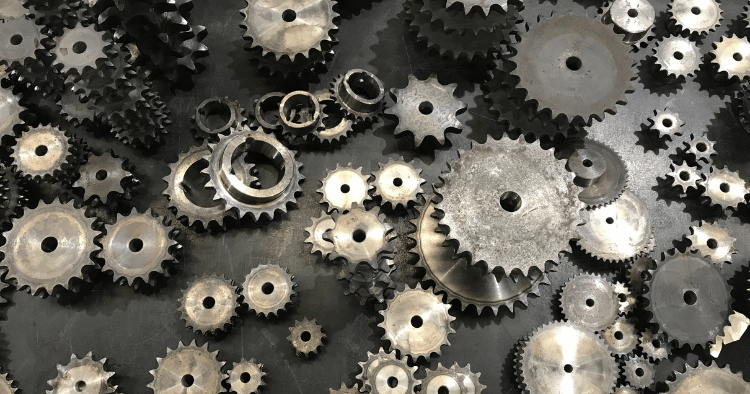
Most came off visibly “rust-free” after some thorough wiping, although Sam had to lightly steel-brush a few ones “to speed up the process” and get the same rust-free result.
According to Sam:
“I used CRC Evapo-Rust with some great results. The photos are time-lapse as well to show the different results. In short, the longer we leave product in solution, the better the results.”
“Rusty sprockets will pose a problem if they are installed as they are. They will work, but the addition of grease will contaminate the lubricant and add to chain and sprocket wear. The trick is to keep the lubricant clear of any contaminants and prolonging the life of all wearing parts. Rust also destroys surface hardness and will accelerate wear."
Does the CRC Evapo-Rust really work?
The quick answer is a yes. It is designed to do one job -- remove rust -- and it does it well, provided, of course, that you use it properly and according to instruction.
Here’s the CRC Evapo-Rust in action:
It “effectively removes even deep rust on all types of mild steels and iron”.
According to the technical data sheet, you should use the product as follows:
- Pre-clean item to remove oil and dirt.
- Rinse item and immerse item fully in Evapo-Rust for 20 minutes.
- Check progress periodically.
- Once rust is removed, rinse the item with water.
- To prevent re-rusting, simply dip the item back in Evapo-Rust solution and allow it to dry.
Note: Deeply rusted parts (5 mm or deeper) may require overnight soaking. Evapo-Rust can be used over and over until performance drops off. When ready to dispose of spent solution, only the iron content of the solution will dictate disposal method. In most cases, it can be safely put down the drain.
How does it work?
EVAPO-RUST® works through selective chelation. This is a process in which a large synthetic molecule forms a bond with metals and holds them in solution. Most chelating agents bind many different metals. The active ingredient in EVAPO-RUST® bonds to iron exclusively. It can remove iron from iron oxide but is too weak to remove iron from steel where the iron is held much more strongly. Once the chelating agent has removed the iron, a sulfur-bearing organic molecule pulls the iron away from the chelator and forms a ferric sulfate complex which remains water soluble. This frees the chelating agent to remove more iron from rust.
More tips from the technical data sheet c/o crceurope.com:
- If Evapo-Rust is used below 15°C, cleaning times will be extended.
- Warmer temperatures will improve rust removal capabilities.
- Store cool (above 0°C) and dry.
How much do I need to use?
That depends a lot on:
- Which product you are using: the spray gel or the liquid solution
- How many items you want to de-rust
- How rusted are the items in question
- How long you "soak” the items in its chemical
While both the spray gel and liquid solution basically have the same formulation, the spray gel “clings” to the surface of the item in question so there’s no need to soak it.
If you have the liquid solution, use it pure and undiluted. It’s ready to use right off the bottle, and there is no need to mix with water.
In Sam’s experiment, he took a 5-litre Evapo-Rust solution container to fully submerge around 100 kilograms of sprockets of various sizes. (Fun fact: According to Microsoft Word, 100 kilograms is around the weight of an average professional basketball player.)
Sam said he was able to “salvage back in the container about ¾ of the Evapo-Rust solution”.
Do I need to fully submerge the whole item, or just the rusted surfaces?
You only need to submerge the rusted areas. If the whole item is badly rusted all over, then yes, you’ll want to submerge it altogether, especially if it’s badly eaten by rust just like the tools and components in this video by CRC NZ:
Will it corrode the rusted metal and other non-metal components?
The Evapo-Rust is safe to use on (not harmful to):
- Aluminium
- Brass
- Copper
- Non-oxide-based paints
- Plastics
- PVCs
- Rubber
- Vinyl
In fact, Sam has another example, this time with his rusty pliers -- that he uses for fishing, so it is riddled with saltwater rust -- that are seized up and wouldn't spring open. After soaking them in 're-used' Evapo-Rust solution for two hours a soaking and a some mild cleaning up with a wire brush, he was happy with the result:
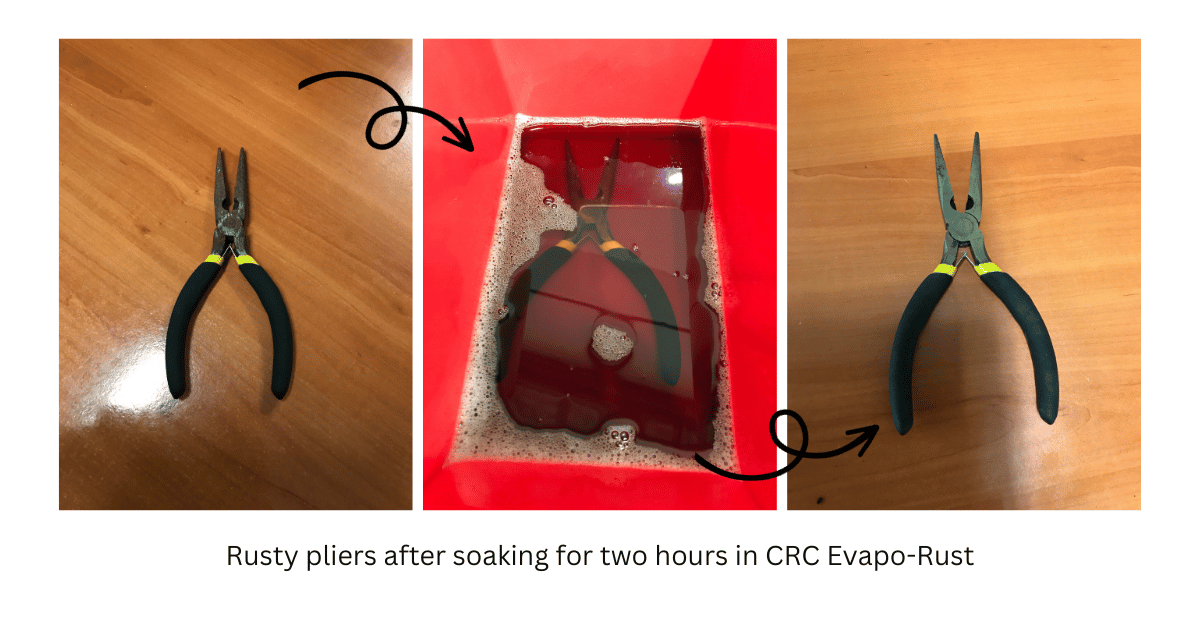
How long do I need to soak the rusted metal in it?
That depends a lot on how badly rusted parts are.
In Sam’s experiment, the sprockets’ surfaces were significantly “rust-free” after a two-hour soak in pure Evapo-Rust but note that they are not heavily rusted to begin with. (He waited it out for another two days.)
Do I need to sand or scrub the rusted item after soaking it in?
Sam had to lightly brush off a few sprockets to achieve the desired result.
Can I reuse the liquid solution?
According to CRC’s video above, the technical data sheet and Sam's pliers example, yes you can reuse the solution “until the performance drops off”.
Is it flammable?
It is “non-caustic”, “non-flammable” and “contains no flammable materials”. We reckon the same is true for the liquid solution. However, keep in mind that it’s still a chemical product best kept away from obvious heat sources and open flames.
Is it harmful, hazardous and toxic?
Please use common sense and observe safety precautions when using the product, but for the record:
- According to the backside label of both the spray gel and liquid solution, they are “not classified as toxic material”, do not contain “acids, alkalis and petroleum” and are not harmful to the user and the environment.
- According to the safety data sheets of both the spray gel and liquid solution, they are “not classified as hazardous” as per Safe Work Australia criteria.
- According to the technical data sheet, they are “safe to use” and contain “no acids, hazardous air pollutants (HAPs) and volatile organic compounds (VOCs)”.
- Both have no strong fumes and odours that can cause irritation under normal conditions. Of course, it’s always best to take extra precautions if you have relevant pre-existing allergies and respiratory conditions.
- It has no food safety certification, although you can use it on parts of food equipment as long as it doesn’t directly come into contact with the food itself. Make sure to wash it off and dry completely before use.
Feedback: Ken H from Perth shared his experience with the CRC Evapo-Rust:
"I have used it on a couple of things, and have had brilliant results. I have just restored two old motorcycles to "as new" condition, and for most of the components a wire buff or grit blasting worked well. But there are a few components which were too delicate for that. One in particular was the tool box on my 1963 A10 BSA.
The sheet steel it is made from is too old/delicate to use grit blasting. The corners and confines make the wire wheel either inaccessible, or dangerous, as it catches on edges. Any acidic medium (if left too long) would dissolve it. Now, these tool boxes are NO LONGER AVAILABLE. They make them in India, and they are either poor quality or just don't fit. Too hit and miss. A second hand one in terrible condition (worse than mine was) sells for $300 - $400 AUD.
So I HAD to save mine.
Evapo-Rust was safe, and can be left as long as you like, as it DOES NOT DISSOLVE BASE METAL.
The greatest point to remember is that Evapo-Rust saturates during use, and it does not convect / self-circulate. So, it will turn black (in areas close to the rust surface) as it absorbs rust, and then stays there against the surface / will not absorb any more. Once saturated, it is no longer of any use = dispose of it.
The best way is to either "stir / circulate" the liquid, or (in a corner where the liquid is "black" and thus saturated) drawn off with a syringe and disposed of / allow unsaturated liquid to continue to work.
See the attached pictures. Before and after:
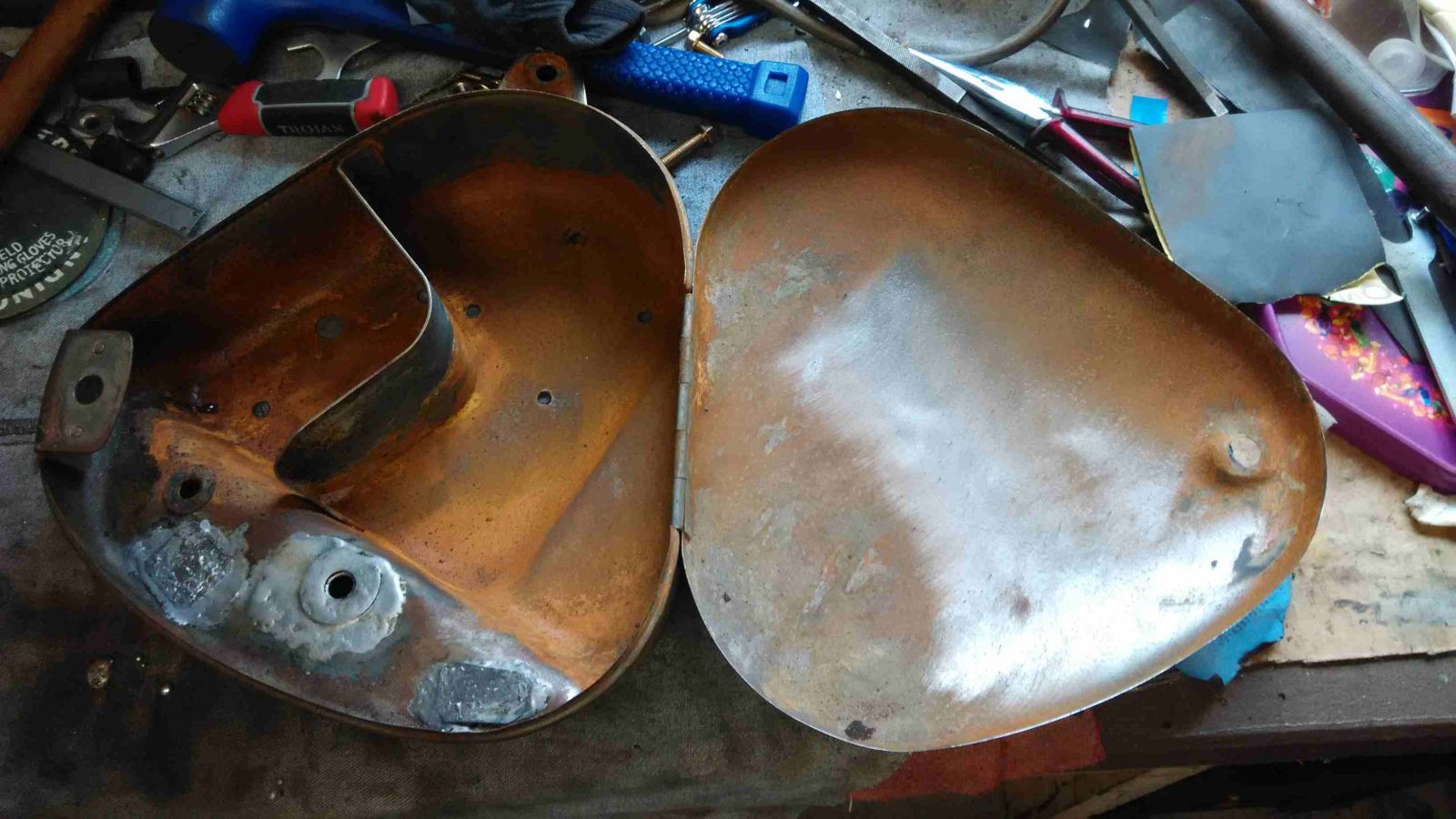
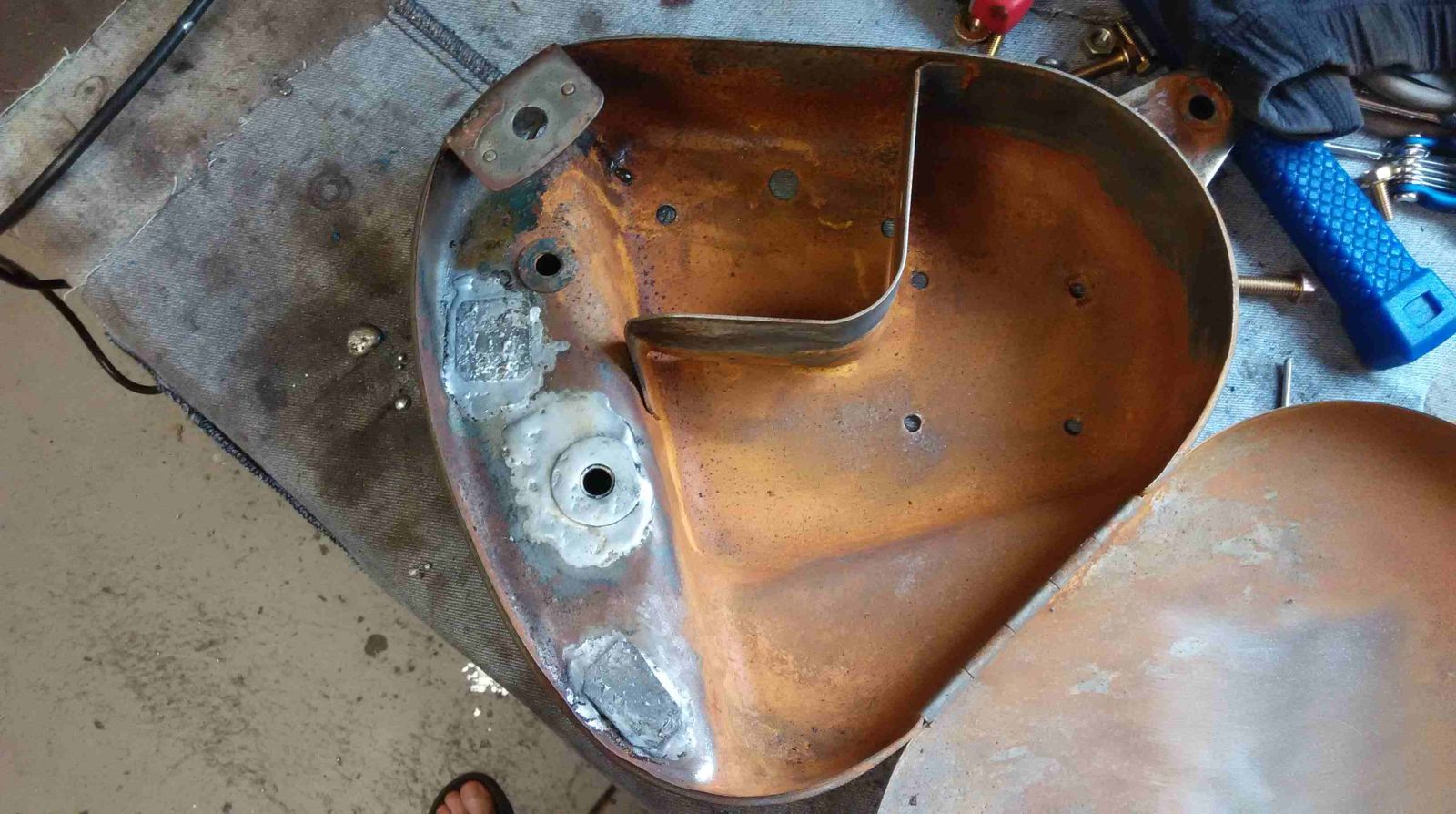
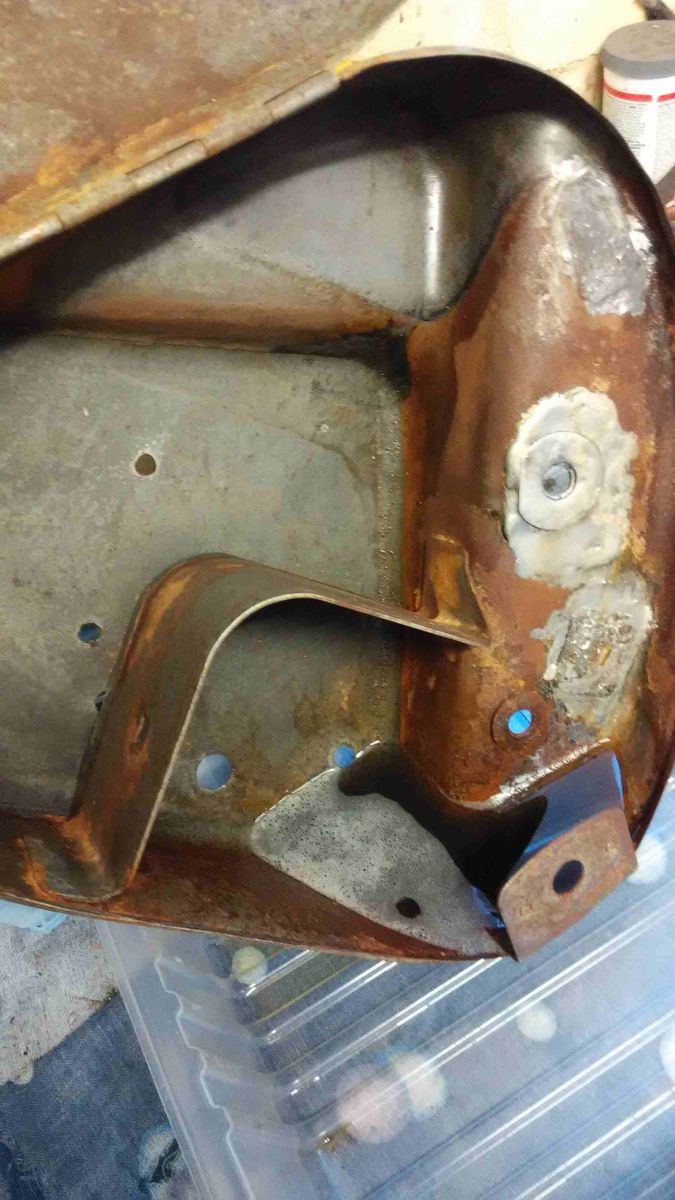
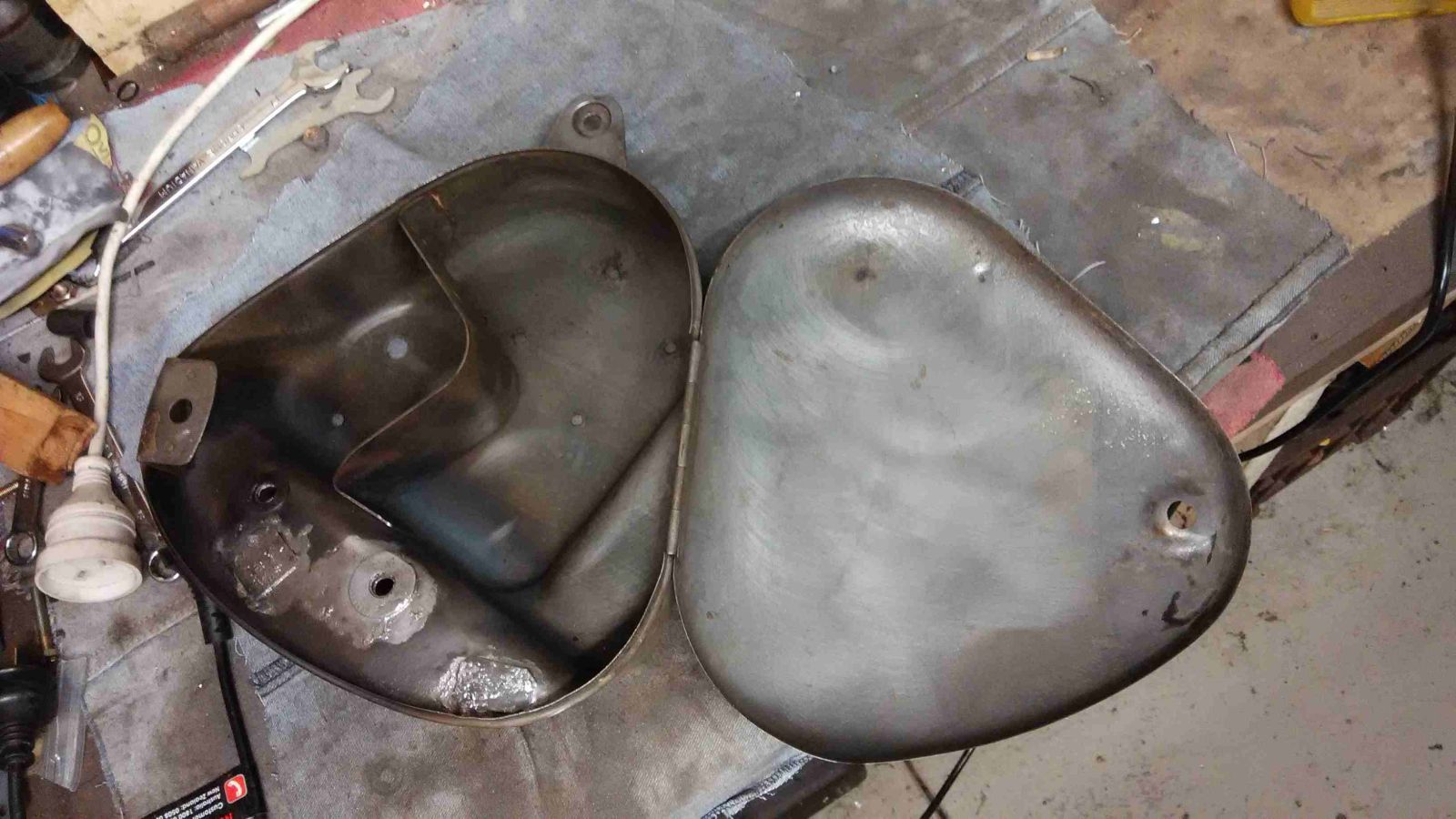
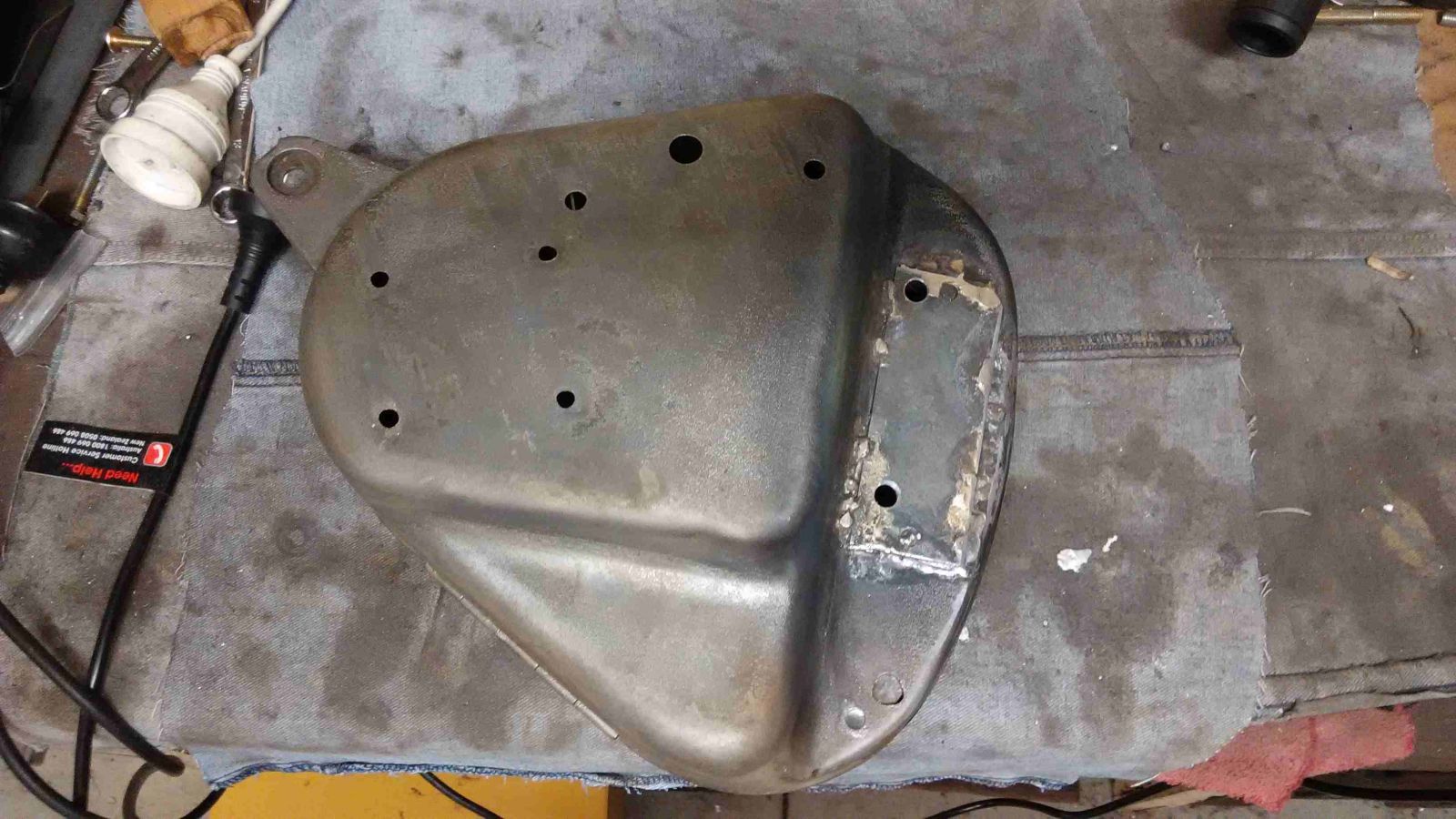
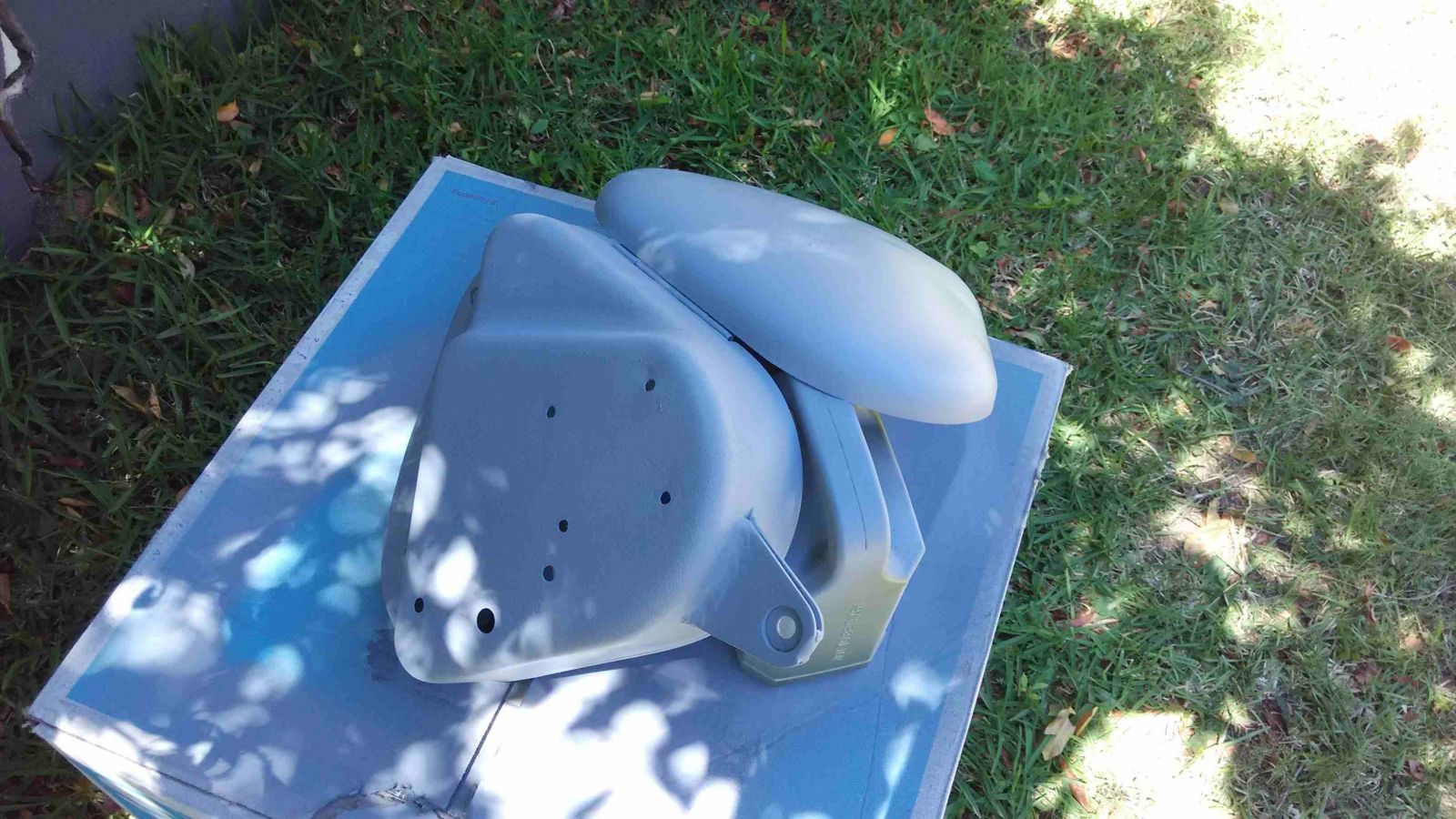
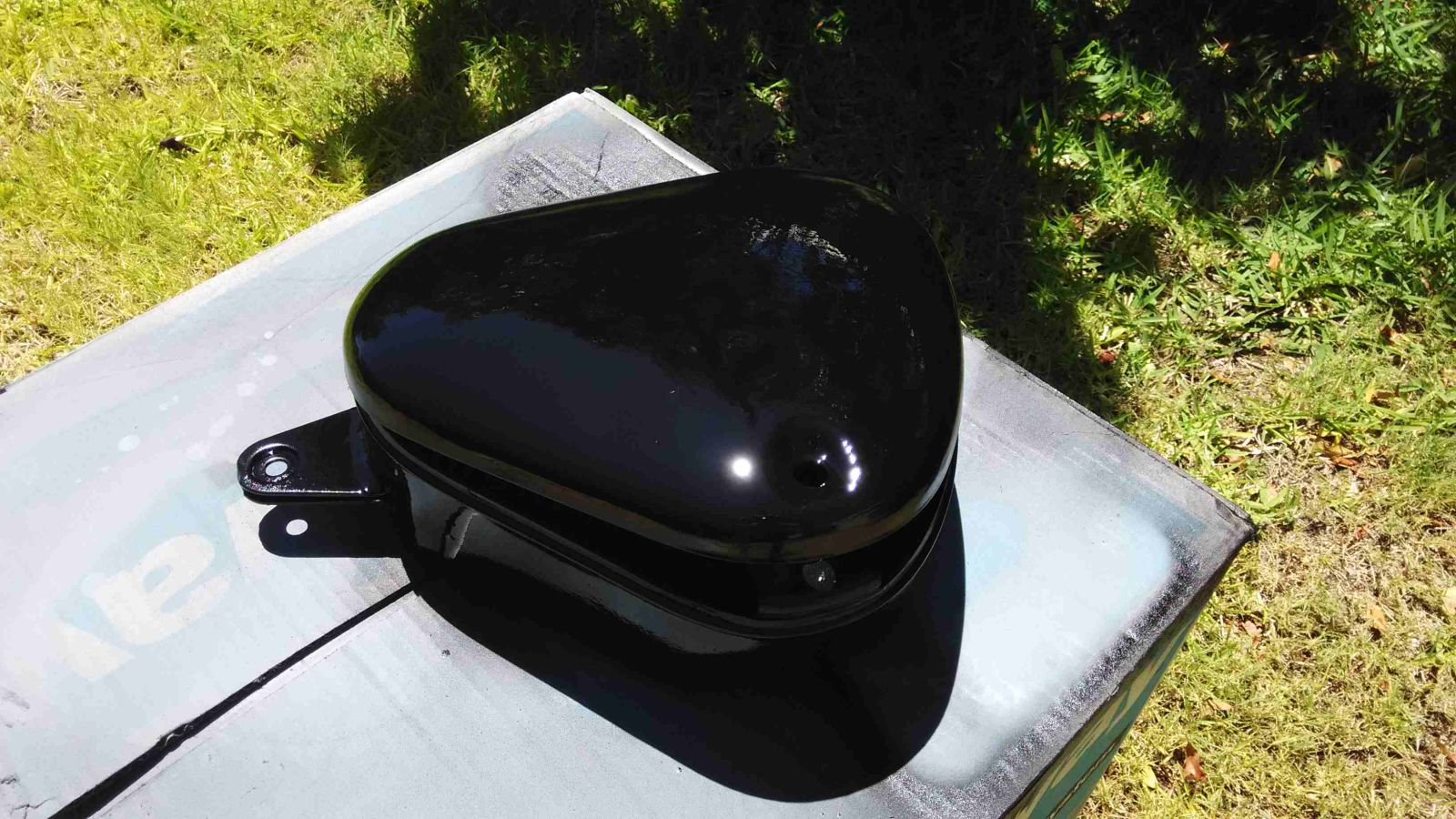
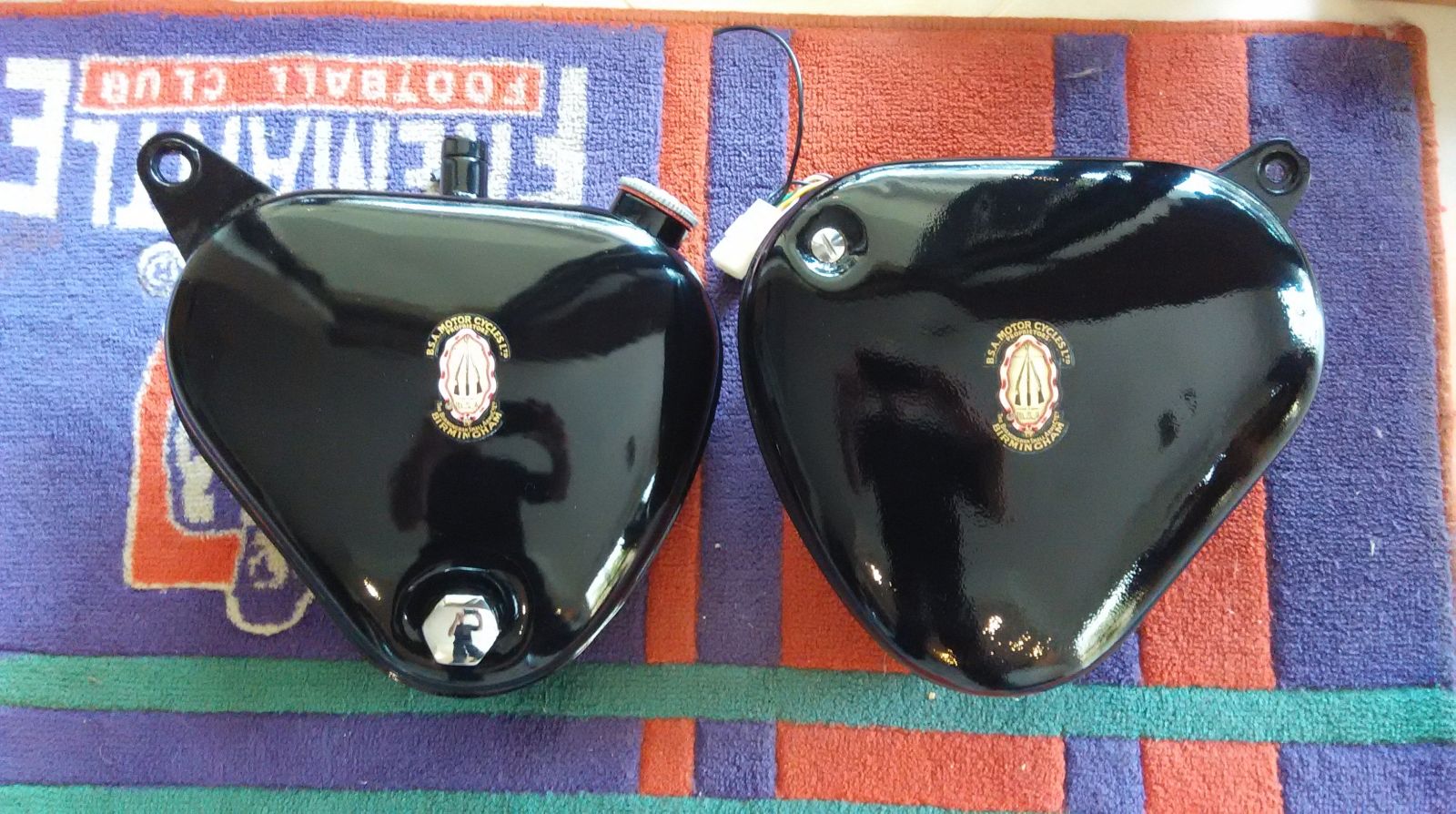
That tool box had sat on that bike for 40 years and had bad chrome with rust pitting under it, rust inside.
Evaopo-Rust cleaned it enough for priming and painting.
I also used it on a Triumph Stag bumper (very hard to get, they make replacements which are nowhere near as good as the original) to remove rust from the rear of it before preservation. The outside is chrome, but the inside barely treated, so they rust.
The Evapo-Rust removes the inside surface rust, with no damage to existing chrome.
It is a brilliant product.
AIMS' Note on Safe Use of Lubricants
- Protective gear: Protect your skin and eyes! Wear chemical-resistant gloves to prevent skin irritation or absorption of chemicals. Safety glasses or goggles provide essential eye protection. Additionally, consider using a respirator if fumes are particularly strong or you are working for an extended period.
- Labels and instructions: Before using any product, carefully read the instructions and safety warnings on the label. Follow the specific guidelines for usage, proper handling and disposal. Check for ‘use by’ dates.
- Fire hazards: Many parts cleaners and lubricants are flammable. Keep them away from open flames, heat sources, and anything that could cause a spark. Store these products in a cool, dry location in their original containers, out of the reach of children and pets.
- Environment: Choose less toxic and environmentally friendly options whenever possible. Make sure there are no open flames or anything that can ignite flammable substances. Dispose of used products and empty containers responsibly according to the instructions or your local hazardous waste guidelines.
- Ventilation: When working with chemicals that release strong fumes, always work in a well-ventilated area, preferably outdoors or in an open area. If you are working indoors, make sure that the windows are open and consider using fans to increase airflow and disperse / vent out the fumes.
.png)
- What is a hot work permit and when do you need one
- Why is a hot work permit necessary
- Who issues hot work permits
- General process in getting a hot work permit
- Key action items and checklist (as per SafeWork NSW)
What is a hot work permit and when do you need one
You'll need a hot work permit in Australia whenever your work involves open flames (eg welding, brazing and soldering), produces sparks or generates hot surfaces with enough heat to ignite flammable materials.
This applies to situations beyond just welding and includes using equipment like:
- Cutting torches
- Grinding tools
- Brazing equipment
- Soldering tools
- Bitumen boilers
General rule: If you are unsure whether your welding work qualifies for a hot work permit, it is always better to err on the side of caution and obtain one.
Exception: You typically won't need a permit if your hot work is done within a designated hot work area specifically designed for such activities, like a welding bay in a workshop. The principle is that these areas should already have built-in safety measures in place to begin with.
Key considerations:
- Many materials and substances found in workplaces are flammable or combustible – be it solids, liquids and gases.
- The risks associated with these materials may not be immediately obvious. For example, flammable substances can release vapors at room temperature that are difficult to detect without special instruments.
- Any hot work process can be a potential ignition source for flammable or combustible materials.
- Serious or fatal injuries can occur when hot works are undertaken on or near flammable or combustible materials without proper control measures. These injuries can result from primary ignition or secondary effects such as smoke, toxic fumes, oxygen depletion or structural collapse.
Why is a hot work permit necessary
The primary purpose of a hot work permit is to:
- Identify hazards: Before commencing actual hot work, the permit forces you to do a thorough assessment of the work area to identify flammable materials, potential fire sources and any other hazards.
- Identify proactive and reactive control measures: It requires you to outline specific steps to proactively reduce risks, such as by (1) assigning a fire watch person and (2) removing flammable items in the work area. In addition, it reminds you to implement reactive measures for just-in-case scenarios, such as by having functional fire extinguishers nearby (ideally with five meters from the actual hot work area) and providing fire blankets for worse case scenarios where the worker(s) need to safely evacuate the area.
- Secure clear authorisation: The permit must be signed by a designated, knowledgeable person in the business to ensure associated risks are understood and mitigated.
- Make workers aware of ongoing hot work: It makes all workers involved aware of the fire risk, the planned precautions and who's responsible for safety.
On a practical note, it’s simply because nobody wants serious fires like this to happen ever again.
Who issues hot work permits
The permit is issued by a designated permit officer in the business / worksite who is authorised by the business to do so, and they typically go by these roles:
- Authorised Officer: He / She is a person authorised by the Works Supervisor to issue hot work permits. This person may also be a Fire Prevention officer.
- Works Supervisor: He / She is responsible for ensuring that hot work permits are issued prior to commencing work and that all necessary precautions are taken.
- Health and Safety Representative (HSR): He / She is a representative elected by the work group to manage health and safety issues. They may also be involved in issuing hot work permits.
- Permit Issuer: He / She is a person authorised by the Works Supervisor to issue hot work permits. This person may also be an Authorised Officer.
Alternatively, they could also be someone in the business / site with these titles:
- Building manager
- Site manager
- Production manager
- Safety officer
The designated permit officer is responsible for -- and has the necessary training and expertise to -- ensuring that hot work permits are issued per the relevant regulations and procedures to ensure the safety of workers and the public.
Note: In general, the designated permit officer should be extensively knowledgeable about the site, safe work practices, and risk assessment especially pertaining to hot work. Keep in mind that specific roles and titles may vary per business / worksite, so make sure to check with your management.
General process in getting a hot work permit in Australia
To get a hot work permit, a risk assessment is first done to identify hazards and put safety measures in place. Then, a permit is filled out with details and authorized by the designed person in the business. Workers involved must be aware of the permit and follow safety precautions.
Specifically, the business should:
1. Identify the hot work activity: Hot work includes activities such as welding, cutting and grinding that produce hot metal, radiant heat and sparks.
2. Assign responsibility: Ensure a competently trained and responsible individual who serves as the designated permit officer (as described in the previous section) will manage the permitting process, and that he / she completely understands associated risks involved and that the risk mitigation measures are in place.
Important:
- The business, employer, PCBU or site manager -- via the designated permit officer -- is primarily accountable and responsible for overseeing the application.
- Individual welders cannot secure a hot work permit for themselves.
- The permit is typically valid for one shift (around 8 hours) only. If the work extends beyond that, a new permit will be needed.
- The permit should be displayed prominently at the worksite.
- A copy of the permit should be kept by the issuer and another copy should be with the person doing the welding for reference.
- There might be slight variations in the process depending on the specific state or territory.
3. Prepare the worksite: The designated permit officer and all involved personnel and contractors should ensure the work area is free from combustible materials prior to commencing actual work. It is ideal to install welding screens or other protective devices to prevent welding flash to onlookers, pedestrians and bystanders.
4. Document the hot work permit: The designated permit officer should ensure the hot work permit includes essential information such as:
- Name of the person performing the hot work
- Location of the hot work process
- Duration of the hot work process and work date, including start and finish times
- Nature of the work (welding, cutting etc)
- Name of the person issuing the hot work permit
- Name of the person performing the fire watch (if different from the person performing the hot work)
5. Monitor and review: Regularly monitor the hot work permit to ensure all hot work activities are conducted according to the regulations and requirements.
6. Inspect post-work and sign off: The designated permit officer must inspect the hot work area after the fact and sign off that it is free of fire hazards (eg no smoldering embers etc) and safe for normal work resumption.
Additional reminders:
- Train employees and contractors: Provide mandatory training on hot work safety to all employees and contractors, especially new staff and contractors. Maintain training records as part of your organization's due diligence.
- Obtain the right equipment: Ensure you have the necessary equipment, including fire extinguishers, welding screens, welding or fire blankets, pylons, caution tape and signage to cordon off the area and provide visual warnings.
- Comply with local regulations: Familiarise yourself with local regulations and standards, such as the WHS Act (Model Work Health and Safety Act) and the Safe Work Australia Welding Processes Code of Practice.
Key action items and checklist (as per SafeWork NSW)
Here is the gist of their action items list (of key considerations in the hot work permitting process):
- Before doing actual hot work, identify and eliminate or control hazards:
- Flammable materials such as rubbish, paper and dust
- Confined spaces
- Sparks and flash by removing combustibles or using covers
- Protect or isolate services (electrical, gas lines, etc)
- Ventilation
- Secure and store gas cylinders safely
- Have firefighting equipment ready
- Limit people and vehicles in the area
- Use a fire watch person to monitor
- Isolate and secure the area with signage
- Train personnel on emergency procedures and evacuation
- Wear proper personal protective equipment
- Check for smoldering embers before leaving the area
Your hot work permit should also cover:
- Housekeeping
- Inspection of worksite
- Identification and handling of hot products after hot work
It should also account for training for all site personnel and contractors regarding:
- Hot work hazards
- Hot work permit system use
- Firefighting equipment use
- Emergency and evacuation procedures
Important: The designated permit officer should inspect the site for safety and sign off on the permit to complete the process.
AIMS’ Note on Buying Industrial Supplies
- Breadth and depth of brands and categories: Go with a supplier that offers a wide range of reputable brands across multiple categories and sub-categories.
- Bulk purchase discounts: For large orders, check if you can take advantage of volume leverage. Some suppliers offer business accounts* that give you access to special pricing (volume discounts), preferential support and even credit eligibility (subject to supplier approval, terms and conditions).
- Product and service information: Evaluate the completeness and usefulness of data in their online product listings. Prudent suppliers will include as much useful information as possible to help you assess and compare products. In terms of service info, the supplier’s FAQs (if any) will give you a good idea of their standard policies*, processes and commitments.
- Promotions: Check for ongoing promotional campaigns so you can get the best prices. Many suppliers run regular discount-based promos. Some can point you to government-hosted rebate programmes like the SafeWork NSW $1000 Small Business Rebate.
- Safety compliance: Make sure the product in question meets Australian safety standards and regulations, especially if there are relevant compliance requirements or work health and safety (WHS) laws that apply to your business or state. Look for relevant certifications and markings where necessary.
- Supplier reliability: Choose reputable suppliers with a proven track record of delivering quality products and reliable customer service.
- Warranty and support: Check warranty terms and after-sales support* options, as this can be crucial in case of product defects or performance issues.
- Lead time and availability: Confirm product availability and estimated delivery times to avoid delays in your projects.
- Returns: Familiarise yourself with the suppliers returns and exchange policy in case you receive incorrect or damaged items.
- Delivery: Clarify delivery terms, including estimated delivery times, shipping costs and who handles insurance during transit (where applicable).
*Need help with a purchase decision? Contact us directly via chat or send an email to sales@aimsindustrial.com.au.
]]>.png)
(Taken from this post by Champion Parts. Republished with permission. Edited for point of view and relevance.)
High tensile bolts are used in applications where durability is critical to firmly and safely hold components together.
A common example would be in an automotive system, where high tensile bolts:
- Hold together the linkages of the suspension system; or
- Attach the brake calipers to the knuckles
Getting this right is important for obvious reasons: safety, reliability and the longevity of components.
This excerpt from Champion Parts might point you in the right direction.
Disclaimer: AIMS is not an expert in fastener design, therefore the information provided herein should not be treated as professional advice. The official source is cited.
Read the head markings
The markings on the head face of a bolt can be confusing. How do we specify the grades between each pattern and make sure you get the correct size?
1. Check if there are any head markings. They will indicate if the bolt is metric or imperial and the grade/class.
.png)
2. Look at the threaded part of the bolt/setscrew and identify if it is a fine thread or coarse thread. Using a vernier, measure the diameter of the threaded part of the bolt/setscrew, as shown in Fig. 1.
3. Use a pitch gauge to determine the pitch of the thread, as shown in Fig. 2.
4. Using a ruler, measure the length of the fastener from under the head, as shown in Fig. 3.
.jpeg)
Corrosion protection
A popular option to avoid corrosion is zinc plating, where a metal bond is formed between the steel and the zinc, which serves as a protective layer.
Zinc-plated fasteners are ideally used in dry environments. Otherwise, stainless steel fasteners may be a better option.
Colour

The colour of the fastener is determined by a pigment additive during the electroplating process. That is why some fasteners appear to be gold (yellow-ish) or silver (clear) in colour.
They do it just to enhance the appearance of the fastener.
It does not have anything to do with durability.
Feedback: Ken H from Perth shared his experience with high-tensile bolts:
"So many people doing restoration have the "stainless is the be all end all" ethos. Definitely not so.
I am on my second old motorcycle rebuild (previous 1963 BSA, this one 1974 Triumph). All the low load bearing fasteners are/will be stainless ("tinware", ie mudguards etc), but anything load bearing/frame/eng mount - all high tensile, they HAVE to be.
In the late 70's the [ship 1 redacted for confidentiality] had a new radar antenna fitted. The rest of the fleet had the same radar fitted, but kept the old antenna; [ship 2 redacted for confidentiality] got the "new/updated" one.
These antennas weigh a couple of tons, are over 20 feet wide, and are subject to extreme stress as the ship rolls. At the mast head, they are at "the end of the pendulum", so stresses exaggerated. You can see one at Darling harbour aboard museum ship HMAC Vampire.
They are held down by a base ring with about 20 in number 3/4 high tensile bolts.
I have been on ships and gone through cyclones with those same antennas. They are designed for it.
Anyway, the [ship 2 redacted for confidentiality] had the new antenna for about a month; when she returned after going through a storm, and it just 'sheered off the bolts and fell over the side.' She had to go back to the old one. The story was they used stainless bolts instead of the high tensile that always required painting. Either that, or incorrect tensile grade/not torqued to correct amount.
Luckily it fell away from the flight deck - no one hurt.
But yes - high tensile bolt selection IS a big deal."
AIMS’ Note on Buying Industrial Supplies
- Breadth and depth of brands and categories: Go with a supplier that offers a wide range of reputable brands across multiple categories and sub-categories.
- Bulk purchase discounts: For large orders, check if you can take advantage of volume leverage. Some suppliers offer business accounts* that give you access to special pricing (volume discounts), preferential support and even credit eligibility (subject to supplier approval, terms and conditions).
- Product and service information: Evaluate the completeness and usefulness of data in their online product listings. Prudent suppliers will include as much useful information as possible to help you assess and compare products. In terms of service info, the supplier’s FAQs (if any) will give you a good idea of their standard policies*, processes and commitments.
- Promotions: Check for ongoing promotional campaigns so you can get the best prices. Many suppliers run regular discount-based promos. Some can point you to government-hosted rebate programmes like the SafeWork NSW $1000 Small Business Rebate.
- Safety compliance: Make sure the product in question meets Australian safety standards and regulations, especially if there are relevant compliance requirements or work health and safety (WHS) laws that apply to your business or state. Look for relevant certifications and markings where necessary.
- Supplier reliability: Choose reputable suppliers with a proven track record of delivering quality products and reliable customer service.
- Warranty and support: Check warranty terms and after-sales support* options, as this can be crucial in case of product defects or performance issues.
- Lead time and availability: Confirm product availability and estimated delivery times to avoid delays in your projects.
- Returns: Familiarise yourself with the suppliers returns and exchange policy in case you receive incorrect or damaged items.
- Delivery: Clarify delivery terms, including estimated delivery times, shipping costs and who handles insurance during transit (where applicable).
*Need help with a purchase decision? Contact us directly via chat or send an email to sales@aimsindustrial.com.au.
]]>.png)
You've probably been in a sticky situation where your glued pieces just keep on falling apart. As a reminder, it’s worth remembering that:
- There is no one-size-fits-all solution when it comes to properly bonding materials together.
- There is an appropriate adhesive to use for certain use cases (especially, industrial applications)
- Your multi-purpose adhesive won’t always cut it (the resulting bond integrity may vary because each substrate has different physical and chemical characteristics)
Speaking of adhesives, it’s hard to talk about the best brands without mentioning LOCTITE®. As a casual user, you have probably used their products to “build things and fix stuff”.
LOCTITE® is not just for casual DIYers who work on home projects. The big guys in various industries use it, too, even for tough niche applications.
In this article, we’ve compiled a host of content (mostly from Henkel) to help you choose the right LOCTITE® product for your intended use. You’ll find information about (and links to):
- Using LOCTITE® for pump maintenance
- Instant adhesives, accelerators and primers
- LOCTITE® product application guide
- General purpose vs specialty adhesive
- Threadlockers for fasteners
- LOCTITE® user guide
- Feedback from users in real-life applications
Using LOCTITE® for pump maintenance
Below is a visual guide from Henkel (and a PDF copy) that shows which LOCTITE® product to use for each part of your pump.
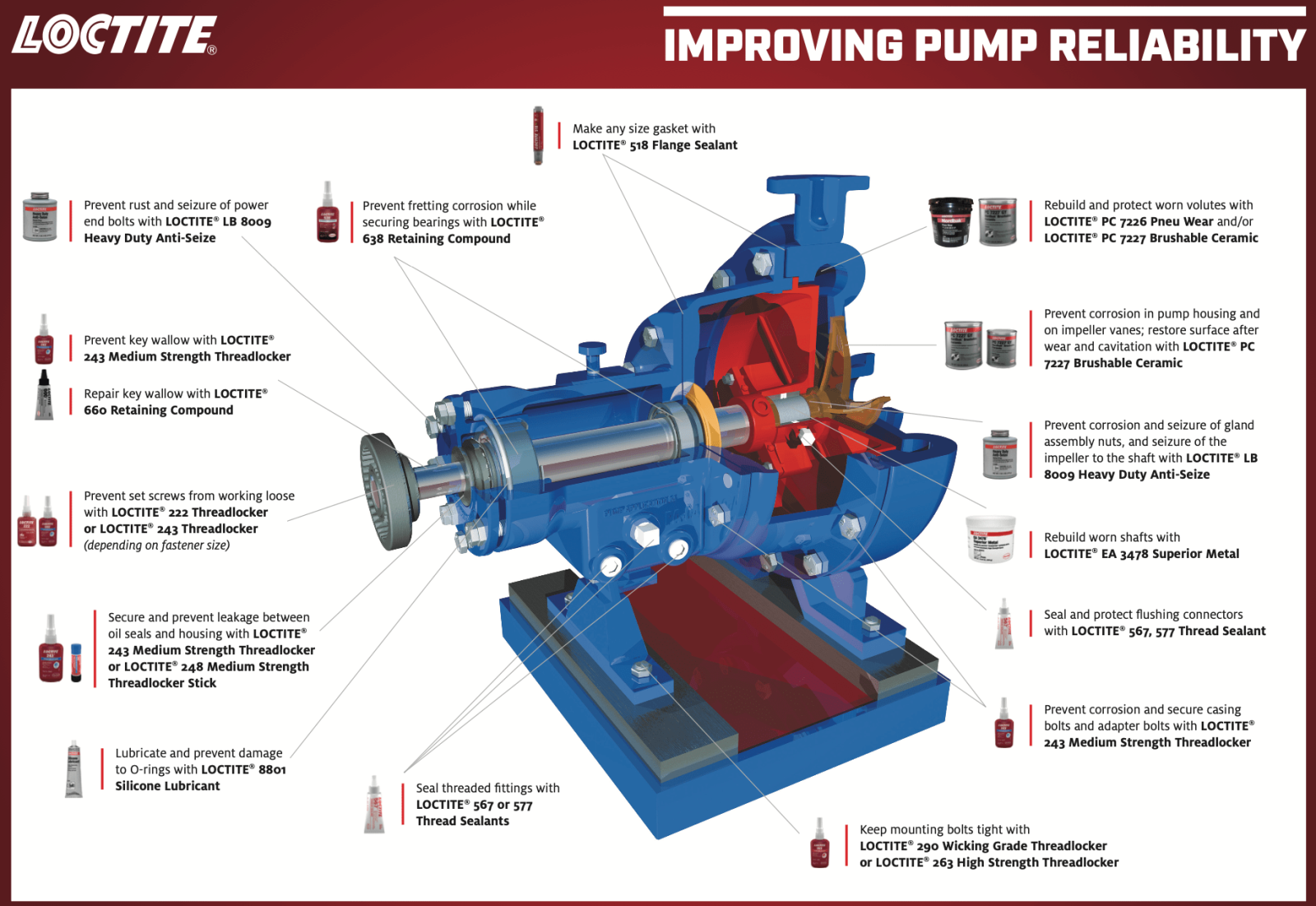
You can buy most of those products from our online store:
- LOCTITE® 222 Threadlocker
- LOCTITE® 243 Medium Strength Threadlocker
- LOCTITE® 248 Medium Strength Threadlocker Stick
- LOCTITE® 263 High Strength Threadlocker
- LOCTITE® 290 Wicking Grade Threadlocker
- LOCTITE® 518 Flange Sealant
- LOCTITE® 567 Thread Sealant
- LOCTITE® 577 Thread Sealant
- LOCTITE® 638 Retaining Compound
- LOCTITE® 660 Retaining Compound
Instant adhesives, accelerators and primers
According to this LOCTITE® selector guide:
Instant adhesives are ideal for bonding small- to medium-size parts with close-fitting, smooth surfaces. They provide fast cure speeds and excellent bond strengths to a wide variety of substrates, including hard-to-bond materials.
You can use them for (almost) anything from general purpose repairs to specialty high-performance assembly applications.
|
Product |
Description |
Best used |
|
LOCTITE 401TM Surface-Insensitive, Medium Viscosity |
A fast-setting, surface-insensitive instant adhesive that provides high shear strength |
When you need a fast fix and high strength on a wide range of materials, including difficult-to-bond substrates |
|
LOCTITE 406TM Low Viscosity |
A fast-curing instant adhesive that is ideal for bonding plastics and elastomeric materials where very fast fixturing is required |
When you need to bond plastic and rubber |
|
LOCTITE 454TM Non-drip Gel |
A general purpose, non-drip gel, instant adhesive |
For overhead and vertical applications |
|
LOCTITE 460TM Low-Odor, Low-Bloom, Low Viscosity |
A low-viscosity, low-odor, low-bloom instant adhesive that rapidly bonds a wide range of materials |
To minimise bondline aesthetic or odor concerns |
|
LOCTITE 480TM Toughened, Low Viscosity |
A toughened, fast-curing instant adhesive that is ideal for bonding metal to metal, rubber or magnets, particularly in humid environments |
For heavy-duty bonding |
|
LOCTITE 3090TM Two-Component Gel |
A unique, two-part instant adhesive that provides gap filling in excess of 0.10" for a wide range of materials |
To fill large gaps |
In addition, you can use accelerators and primers:
- Accelerators speed up the cure and increase the gap fill of instant adhesives
- Primers allow for improved adhesion on hard-to-bond substrates by making polyolefin and other low-energy surfaces suitable for bonding with instant adhesives.
LOCTITE® product application guide
Below are snapshots taken directly from this handy PDF by Henkel. It shows us which LOCTITE® product(s) -- and recommended primers, in some instances – to use for what application, taking into consideration operating temperatures.









General purpose vs specialty adhesive
When choosing an instant adhesive, it’s important to know the different types and what they’re specifically designed for:
- General purpose adhesives are strong and versatile enough for the vast majority of applications, including acidic surfaces such as chromated or galvanized metals and porous substrates such as wood paper, leather, cork and fabric.
- Flexible adhesives are best for bonding materials subjected to bending or distortion, as well as flexible components. Use them where elasticity, pliability, and plasticity are important. The industrial grade ones are even suitable for both gap-filling and sealing techniques, as well as strong adhesion between numerous substrates, flexible adhesive solutions provide excellent curing speeds and fixing times.
- High gap fill adhesives are best for applications with gaps up to 0.15 mm. 2-K technologies provide fast cure independent of gaps up to 5 mm.
- High temperature adhesives can withstand operating temperatures up to 120 °C.
- Light cure adhesives are designed to cure very rapidly upon exposure to UV / visible light of the proper intensity.
- Low odour / low bloom adhesives are low-volatile adhesives are best for applications where cosmetic appearance, minimal frosting and low odour are required.
- Toughened / Elastomer modified adhesives are best for applications subjected to high shock, impact and humidity.
For heavy-duty and industrial applications, it’s best to refer to this list by Henkel, where they discuss these adhesives in greater detail:
- Laminative adhesives
- Optically clear adhesives
- Structural inserts
- Water-based adhesives
- Assembly film adhesives
- Die attach adhesives
- Electrically conductive adhesives
- Flexible adhesives
- Hot melt adhesives
- Pre-applied adhesives and sealants
- Pressure-sensitive adhesives
- Retaining compounds
- Solvent-based adhesives
- Structural adhesives
- Threadlockers
- UV adhesives and sealants
Threadlockers for fasteners
Threadlocking adhesives, such as LOCTITE® threadlockers, are formulated to “eliminate the potential of loosening, leakage and failure by locking your fasteners in place”, according to this article from Henkel.
They really make a big difference, as you’ll see in this video:
More threadlocker reminders from Henkel’s article:
- Using the wrong type of threadlocker could lead to reduced reliability, difficulties with removal and improper curing. This may impact how well your adhesive locks assemblies in place, increasing the chance of loosening and failure.
- Consider the size of the thread, as getting it wrong can make servicing or disassembly more difficult. Generally speaking, the larger your thread, the higher the strength your threadlocker needs to be.
- The ease with which a threadlocker can be removed depends on its strength.
- Low and medium strength threadlockers can be removed with standard hand tools.
- High or permanent strength threadlockers may require direct, intense heat application to disassemble.
- For high temperature applications, choose a threadlocker with higher heat resistance, such as LOCTITE® 263.
- For applications with a high risk of vibration or shock, choose LOCTITE®’s red threadlockers (just take note that, as they are the “strongest grade”, they “hold firmly in place as a permanent solution.”
- For applications where the fastener is pre-assembled (eg. electrical connects and set screws), use a wicking grade threadlocker such as the LOCTITE® 290.
LOCTITE® threadlockers come in three strength grades:
- The low-strength LOCTITE® 222 works on all metals, and is especially good for applications that may require disassembly.
- The medium-strength LOCTITE® 243 offers a good general-purpose solution to seal and secure assemblies.
- The high-strength LOCTITE® 263 is designed for permanent locking and sealing of threaded fasteners.
Speaking of LOCTITE® threadlockers, here are some myth-busters from Henkel themselves:
LOCTITE® user guide
Finally, here’s an oldie-but-goodie guide to help you "Do It Right” when it comes to using LOCTITE® maintenance products.
Feedback: Ken H from Perth shared his experience with Loctites:
"With a weapons radar fitting (gun and missile radar direction systems) background, I used all the Loctites at work, and now have a dozen different sorts in the garage that I use every day. I mainly use it in garage now (retired, 8 vehicles, mostly old ones, 1963 through to current) and it is essential; but I still have a full kit (ex work) and all the charts.
I use mostly 243 (old bikes, use on everything, currently rebuilding 1974 Triumph Trident motorcycle) 262 (engine drive train components), bearing mount (two grades, yellow and blue) , and have/use three grades of Loctite gasket. The primer (7471) is essential for oily engine "critical" components, like cam sprockets/tensioners that will never bond otherwise. My Triumph Stag and Dolomite Sprint have tiny chain tensioner bolts that have to be exact tension, (must be tight, but easy to snap) and if they loosen = catastrophic damage. Primer and 243 ONLY thing that works.
The greens should come with a warning, as if they bond properly, the average person will never get them off if they don't "get it" and use by mistake. Mainly for earthmoving/mining applications, so not mainstream.
Again, Loctite is essential to anyone serious about fastener retaining.
With skills in fitting/mech fields declining/becoming "shallower" (most just replace whole units/next higher assembly) the more info available the better.
So again, thanks for the info, and good that you provide it."
AIMS’ Note on Buying Industrial Supplies
- Breadth and depth of brands and categories: Go with a supplier that offers a wide range of reputable brands across multiple categories and sub-categories.
- Bulk purchase discounts: For large orders, check if you can take advantage of volume leverage. Some suppliers offer business accounts* that give you access to special pricing (volume discounts), preferential support and even credit eligibility (subject to supplier approval, terms and conditions).
- Product and service information: Evaluate the completeness and usefulness of data in their online product listings. Prudent suppliers will include as much useful information as possible to help you assess and compare products. In terms of service info, the supplier’s FAQs (if any) will give you a good idea of their standard policies*, processes and commitments.
- Promotions: Check for ongoing promotional campaigns so you can get the best prices. Many suppliers run regular discount-based promos. Some can point you to government-hosted rebate programmes like the SafeWork NSW $1000 Small Business Rebate.
- Safety compliance: Make sure the product in question meets Australian safety standards and regulations, especially if there are relevant compliance requirements or work health and safety (WHS) laws that apply to your business or state. Look for relevant certifications and markings where necessary.
- Supplier reliability: Choose reputable suppliers with a proven track record of delivering quality products and reliable customer service.
- Warranty and support: Check warranty terms and after-sales support* options, as this can be crucial in case of product defects or performance issues.
- Lead time and availability: Confirm product availability and estimated delivery times to avoid delays in your projects.
- Returns: Familiarise yourself with the suppliers returns and exchange policy in case you receive incorrect or damaged items.
- Delivery: Clarify delivery terms, including estimated delivery times, shipping costs and who handles insurance during transit (where applicable).
*Need help with a purchase decision? Contact us directly via chat or send an email to sales@aimsindustrial.com.au.
]]>.png)
We’ve seen it in the news:
- Dire warning for millions of Aussies over severe weather: “A hellish summer looms for Aussies after a long-term forecast revealed there could be a higher risk of heatwaves and bushfires over the next seven months.”
- Aussies face scorching summer as El Nino predicted to last until April 2024: “The World Meteorological Organization (WMO) has released the latest “hot” announcement — El Nino is here to stay for a long time. Temperatures are expected to soar from November all the way until January.”
The Bureau of Meteorology (BoM) forecasts that from December 2023 to February 2024:
- The maximum and minimum temperatures are at least 2.5 times more likely than normal to be unusually high (above median) for much of Australia.
- Rainfall is likely to be below average across much of northern and western Australia and much of Tasmania.
You’re probably even feeling the heat in your skin. It’s not even officially summer but it somehow already feels like it. Nevertheless, business must go on. The risks of dehydration, heat-related illness and heat stress shouldn’t be taken for granted, especially during the hot weeks ahead.
- Common effects of working in heat
- Health and safety duties
- How to manage the risks of working in heat
- First aid for heat-related incidents in the workplace
Disclaimer: AIMS is not a work health and safety (WHS) expert, therefore the information provided herein should not be treated as legal or professional advice. This article only aims to compile resources that may be helpful to your business. Official sources of information are cited. No copyright infringement is intended.
Common effects of working in heat
Maintaining a normal body temperature is crucial for the health and safety of workers. When the body works excessively to cool down or begins to overheat, it can be vulnerable to heat-related illnesses.
When we say working in heat, we mean any work that involves “in or near heat”. That applies to any work performed indoors and outdoors, regardless of time of the day and season (although we can agree that the risks are higher during summer).
According to Safe Work Australia (SWA) in their Guide for managing the risks of working in heat:
- Working in heat can be hazardous and can cause harm to workers.
- As a person conducting a business or undertaking (PCBU), you have a duty to keep workers and your workplace safe from the risks of working in heat (which we cover in the next section).
- Workers may suffer from heat-related illness if the body has to work too hard to keep cool or starts to overheat.
- Heat-related illness is a “general term to describe a range of progressive heat-related conditions including fainting, heat rash, heat cramps and heat stroke.”
Moreover, the guide lists the common primary symptoms of heat-related illness as:
- Dehydration from increased sweating if workers aren’t drinking enough water
- Heat rash that leads to skin irritation and discomfort
- Heat cramps that result from heavy sweating without replacing salt and electrolytes
- Fainting particularly when workers stand or rise from a sitting position
- Heat stroke from when the body can no longer cool itself, which can be fatal, so make sure to check the ‘First aid’ section below
There are also secondary symptoms that should also be taken seriously:
- Burns can occur if a worker comes into contact with hot surfaces or tools, so make sure they are using heat-resistant gloves.
- Slips, as a worker will sweat more in hot conditions which can increase the risk of slips (eg a worker might slip when using sharp tools if their hands are damp).
- Reduced concentration that can lead to confusion and increased likelihood of making mistakes, such as forgetting to guard machinery.
- Increased chemical uptake into the body may occur as the heat causes the body to absorb chemicals differently and can increase the side effects of some medications.
Note: How hot a worker feels will be different in every situation, depending on the individual worker, the work they are doing and the environment in which they are working.
Health and safety duties
Exposure to high temperatures during work poses significant hazards and can lead to harm for employees. As a business, it's your responsibility to ensure the safety of both your workforce and the workplace, mitigating the risks associated with working in heat.
Moreover, safety should be a priority across the board, as everyone is expected to take all reasonably practicable measures to eliminate -- or at least minimise -- the risks of working in heat.
PCBUs (Persons Conducting a Business or Undertaking) and officers are obligated to take reasonable measures to ensure that employees, volunteers and anyone else involved in the business are not exposed to health and safety hazards. In relation to working in heat, they must ensure:
- Proper ventilation to enable workers to carry out their tasks without compromising health and safety
- Workers operating in extreme temperatures, either hot or cold, can perform their duties without endangering their health and safety
We covered the WHS laws in this article, and specifically the PCBU compliance to ‘primary duty of care’ in this section (in relevance to WHS Act Section 19).
As for workers and ‘other persons at the workplace’, they have a duty to take reasonable care of their own health and safety and to not adversely affect the health and safety of other persons. They are expected to comply with reasonable instructions, as far as they are reasonably able, and cooperate with reasonable health and safety policies or procedures that have been notified to them.
How to manage the risks of working in heat
The section ‘Managing the risks of heat’ of the Guide for managing the risks of working in heat (page 7) provides comprehensive guidelines to manage the risks associated with working in heat. It outlines a structured approach that involves consultation, identification, assessment, control and review of the risks.
Here is a breakdown:
- Identification of hazards: Assess various factors such as air temperature, flow, humidity, radiant heat sources, and work requirements to identify heat-related hazards. You should also engage all duty holders and the workers themselves to review incident records, including near-misses, to help identify risks at your workplace.
- Risk assessment: Determine the severity and likelihood of risks, considering various factors such as work environment, physical exertion, personal protective equipment (PPE) and clothing worn, individual health conditions and forecasts / potential impact of heatwaves.
- Risk control: Remember that heat that represents a hazard to workers may be generated by more than just weather conditions. Hence, you may find a combination of controls to be the most effective for mitigating relevant risks. Here are some examples of ways you could manage the risks associated with working in heat using the following approaches:
Approach
How
Example
Elimination
Remove the risk if reasonably practicable.
Cancel work tasks or wait for hot conditions to pass.
Substitution
Replace hazardous practices with safer alternatives.
Have workers do work in a cooler environment.
Isolation
Physically separate the source of harm from workers.
Separate workers from hot machinery. Use physical barriers (ie cones and fencing) to ensure it is clear where the hot machinery is located.
Engineering controls
Implement control measures that are physical in nature, including a mechanical device or process.
Set up physical measures such as shade tents, cooling systems and industrial fans, insulation and air flow improvements.
Administrative controls
Implement procedures, training, supervision and emergency plans.
Schedule more physically demanding activities to be completed in the cooler parts of the day. Or, if possible, ensure workers are not working alone so there is always a buddy that can call for help should the unfortunate happen.
PPE
Use suitable safety wearables, considering their limitations and potential impacts on heat-related risks.
Modify uniforms or dress codes so workers can wear cooler and more breathable clothing (without compromising safety)
Acclimatization
Consider the body’s adaptation to heat.
Consult safety professionals, such as an occupational hygienist, to help you implement relevant safety measures.
Hydration
Ensure access to cool drinking water and electrolyte replacement therapy when needed.
Make sure hydrating beverages such as Sqwincers (kept cold in portable coolers) are always available on work sites for all workers.
- Review of control measures: Regularly review and assess the effectiveness of implemented controls. It’s best if you involve workers in the review process, monitor incidents, and consider new developments or information to refine control measures.
The emphasis lies on a thorough assessment of factors affecting heat exposure, implementing a range of control measures, providing appropriate training, monitoring workers and continuously reviewing the effectiveness of measures taken.
First aid for heat-related incidents in the workplace
According to SWA: “Heat-related illness is a progressive condition and if left untreated it can be fatal. If you think someone has severe heat exhaustion, or heat stroke, you should call an ambulance immediately and perform first aid until an ambulance arrives.”
For the early stages of heat-related illness first aid can often be effective, but you should always seek medical assistance if in doubt, or if the person’s symptoms are severe.
|
Symptom |
Signs |
First aid (“them” refers to the worker) |
|
Dehydration |
|
|
|
Heat rash
|
|
|
|
|
|
|
Fainting |
|
|
|
Heat stroke |
*Not all heat-induced signs may be present |
Call 000 emergency services immediately. Follow the DRSABCD action plan. Move the worker where it’s cooler, less humid and has better air circulation. Loosen tight clothing (and remove unnecessary clothes). Cooling methods (if safe):
Alternatives if no cold bath:
Supportive care:
|
Important: Workers taking specific medications, having pre-existing medical conditions or prior heat-related illnesses are at a heightened risk of experiencing heat-related issues. This influences the appropriate approach to their treatment. It's crucial to inform employees about this risk and, as much as feasibly possible, closely monitor them for any signs of heat-related illness.
More resources from Safe Work Australia:
- https://www.safeworkaustralia.gov.au/safety-topic/hazards/working-heat
- https://www.safeworkaustralia.gov.au/safety-topic/hazards/working-heat/frequently-asked-questions
- https://www.safeworkaustralia.gov.au/safety-topic/hazards/working-heat/checklist-managing-risks-heat-workplace
- https://www.safeworkaustralia.gov.au/safety-topic/hazards/working-heat/first-aid-heat-related-illness
- https://www.safeworkaustralia.gov.au/safety-topic/hazards/working-heat/resources
- https://www.safeworkaustralia.gov.au/resources-and-publications/fact-sheets/managing-risks-working-heat-fact-sheet
- https://www.safeworkaustralia.gov.au/resources-and-publications/fact-sheets/infographic-working-heat
AIMS’ Note on Buying Industrial Supplies
- Breadth and depth of brands and categories: Go with a supplier that offers a wide range of reputable brands across multiple categories and sub-categories.
- Bulk purchase discounts: For large orders, check if you can take advantage of volume leverage. Some suppliers offer business accounts* that give you access to special pricing (volume discounts), preferential support and even credit eligibility (subject to supplier approval, terms and conditions).
- Product and service information: Evaluate the completeness and usefulness of data in their online product listings. Prudent suppliers will include as much useful information as possible to help you assess and compare products. In terms of service info, the supplier’s FAQs (if any) will give you a good idea of their standard policies*, processes and commitments.
- Promotions: Check for ongoing promotional campaigns so you can get the best prices. Many suppliers run regular discount-based promos. Some can point you to government-hosted rebate programmes like the SafeWork NSW $1000 Small Business Rebate.
- Safety compliance: Make sure the product in question meets Australian safety standards and regulations, especially if there are relevant compliance requirements or work health and safety (WHS) laws that apply to your business or state. Look for relevant certifications and markings where necessary.
- Supplier reliability: Choose reputable suppliers with a proven track record of delivering quality products and reliable customer service.
- Warranty and support: Check warranty terms and after-sales support* options, as this can be crucial in case of product defects or performance issues.
- Lead time and availability: Confirm product availability and estimated delivery times to avoid delays in your projects.
- Returns: Familiarise yourself with the suppliers returns and exchange policy in case you receive incorrect or damaged items.
- Delivery: Clarify delivery terms, including estimated delivery times, shipping costs and who handles insurance during transit (where applicable).
*Need help with a purchase decision? Contact us directly via chat or send an email to sales@aimsindustrial.com.au.
]]>.png)
(Taken from Advance Anti-Slip Surfaces. Republished with permission. Edited for point of view, recency and relevance.)
Slips, trips, stumbles, tumbles and falls are the highest frequency safety risks in most industries and workplaces today.
The severity of each possible hazard can depend on the industry, the situation and the person, but one small slip, stumble, trip, tumble or fall has the potential to cause a serious incident or injury or, in the worst-case scenario, even a fatality. These can lead to the possibility of legal liability, lost production time, and lengthy workplace absences.
Businesses also have a duty of care for the well-being of their employees, contractors, visitors and customers, which could mean serious consequences if one of them were injured while ascending or descending a ladder in your workplace.
- Why you should care about anti-slip ladder rung covers
- Why you need them
- The key benefits that they offer
Understanding anti-slip ladder rung covers
When it comes to health and safety, there should be no shortcuts. That is why it is essential that an anti-slip hazard control measure is recommended throughout all locations, and in every facility.
In this article, let's focus on ladders.
Ladders are indispensable tools in various settings, everywhere from commercial, industrial workplaces to mobile machinery and equipment. Nevertheless, they come with inherent risks, especially when used in slippery conditions. Since they are commonplace in various industries, and their proper maintenance and safety features are crucial to prevent accidents and injuries.
Installing non-slip ladder rung cover products will (1) maximise pedestrian safety and (2) prevent many incidents and injuries that hurt people, reduce productivity and increase costs.
That's where Advance Anti-Slip ladder rung covers come into play. Their rung covers are designed to provide an additional layer of safety, helping to reduce the risk of slips and falls when climbing ladders. They also meet Australian safety standards, such as the AS 1657-2018 for fixed platforms, walkways, stairways, and ladders.
Why do you need anti-slip ladder rung covers?
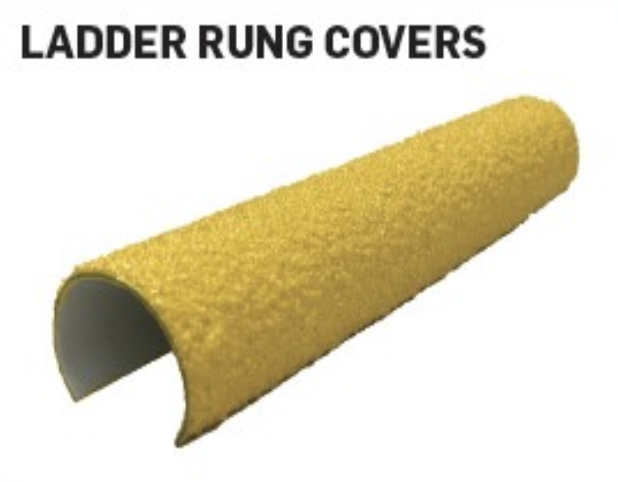 Non-slip ladder rung covers are essential because they:
Non-slip ladder rung covers are essential because they:
- Provide a greater surface area on the ladder rung for people to step on
- Provide a visual reference point for people, including people with a vision impairment, and make the rungs more visible to prevent a possible fall
- Support and protect the rung from unnecessary wear and tear or any possible impact damage, which extends the useful life of the ladder
- Provide a firm footing, keeping people safe from a slip, stumble or fall
- Mitigate any possible liability resulting from an accident if one does occur
- Provide a safer access for workers, contractors and visitors
- Reduce accidents, medical and insurance costs, lost productivity, and increases morale
- Deliver firm footed traction from the top to the bottom of the ladder
For a variety of reasons, ladders can often become hazardous. Anti-slip ladder rung covers are an effective way to provide extra grip to the rungs where people tread most frequently.
A half-round ladder rung cover just doesn’t provide enough non-slip surface area on the ladder rung. The heel of a person’s boot can catch lower on the rung cover which could almost turn a half round rung cover into a secondary trip hazard.
You'll often see ladder rung covers in industrial and workplace applications, such as in:
- Construction: To keep workers safe on scaffolding and elevated work platforms
- Manufacturing: To improve safety on factory floors and assembly lines
- Warehousing: To prevent accidents in distribution centres and storage facilities
- Maintenance: Essential for facility management and repair work
- Utilities: To protect utility workers during pole and tower climbs
Their performance has been tested even in some of the world's toughest environments, including:
- Offshore drilling platforms
- Marine vessels
- Greasy food processing facilities
- Dusty manufacturing plants
- Automotive refinishing operations
- Power generation facilities
Key benefits of anti-slip ladder rung covers
- Safety in diverse environments: Anti-slip ladder rung covers are versatile and suitable for various environments, including construction sites, silo’s, shipping, defence facilities, factories, warehouses, and even on the top of most tall buildings.
- Regulatory compliance: Many safety regulations and standards -- such as those set by various workplace occupational safety and health administrations -- require the use of anti-slip solutions on ladders and other elevated work platforms.
- Enhanced traction: The primary purpose of anti-slip ladder rung covers is to offer improved traction. They are coated with carborundum materials that provide a secure grip for your feet, even in wet or oily conditions.
- Durability: Advance Anti-Slip ladder rung covers are crafted from robust materials, ensuring they will withstand the test of time and frequent use. They are designed to be resistant to many chemicals, corrosion, fire and harsh weather conditions, as well as the constant abuse of boot traffic up and down the ladder.
- Ease of installation: Installing these covers is usually a straightforward process. They can be quickly attached to your ladder's existing rungs, making it a cost-effective and quick safety upgrade.
- Customisation: Advance Anti-Slip ladder rung covers come in different sizes and designs to accommodate various ladder types and rung dimensions.
Why choose Advance Anti-Slip Surface ladder rung covers
Advance Anti-Slip Surfaces' Class 1, metal-backed and non-slip ladder rung covers provide a full 270 degrees of slip protection, exactly where it is needed the most. They are available in circular and square styles that snap fit easily over the rung to provide a long-lasting, highly visible surface to climb on.
Their performance has been tested in some of the world's toughest environments, including offshore drilling platforms, marine vessels, in greasy food processing facilities, dusty manufacturing plants, automotive refinishing operations, and power generation facilities.
Advance Anti-Slip Surfaces is an Australian-owned manufacturer and supplier of an extensive range of class-one metal-backed anti-slip ladder rung cover safety products.
These durable non-slip rung covers resist corrosion and impacts, providing years of anti-slip protection in a variety of environments, from offshore drilling platforms to commercial applications. They are available in circular and square profiles to easily fit over existing ladder rungs.
Advance Anti-Slip Surfaces’ non-slip products comply with national and international standards for quality, performance and safety.
They are also backed by an extensive warranty.
Shop for Advance Anti-Slip ladder rung covers now.
AIMS’ Note on Buying Industrial Supplies
- Breadth and depth of brands and categories: Go with a supplier that offers a wide range of reputable brands across multiple categories and sub-categories.
- Bulk purchase discounts: For large orders, check if you can take advantage of volume leverage. Some suppliers offer business accounts* that give you access to special pricing (volume discounts), preferential support and even credit eligibility (subject to supplier approval, terms and conditions).
- Product and service information: Evaluate the completeness and usefulness of data in their online product listings. Prudent suppliers will include as much useful information as possible to help you assess and compare products. In terms of service info, the supplier’s FAQs (if any) will give you a good idea of their standard policies*, processes and commitments.
- Promotions: Check for ongoing promotional campaigns so you can get the best prices. Many suppliers run regular discount-based promos. Some can point you to government-hosted rebate programmes like the SafeWork NSW $1000 Small Business Rebate.
- Safety compliance: Make sure the product in question meets Australian safety standards and regulations, especially if there are relevant compliance requirements or work health and safety (WHS) laws that apply to your business or state. Look for relevant certifications and markings where necessary.
- Supplier reliability: Choose reputable suppliers with a proven track record of delivering quality products and reliable customer service.
- Warranty and support: Check warranty terms and after-sales support* options, as this can be crucial in case of product defects or performance issues.
- Lead time and availability: Confirm product availability and estimated delivery times to avoid delays in your projects.
- Returns: Familiarise yourself with the suppliers returns and exchange policy in case you receive incorrect or damaged items.
- Delivery: Clarify delivery terms, including estimated delivery times, shipping costs and who handles insurance during transit (where applicable).
*Need help with a purchase decision? Contact us directly via chat or send an email to sales@aimsindustrial.com.au.
]]>.png)
Are you working in a caustic environment where corrosion is an important factor in material selection? Are you concerned about rust forming on structural parts and fasteners due to a wet or moist environment?
If so, then fasteners made of stainless steel may be the answer to your problem.
Many people ask us these questions:
- Which is better between 304 and 316 stainless steel fasteners?
- What's the difference between 304 and 316 stainless steel?
- Why does rust still form around stainless steel?
- Is 316 stainless steel suitable for seawater immersion?
- Is well-polished stainless steel maintenance-free?
We hope this article gives you a basic understanding of stainless steel and the best choice for your intended use, especially when it comes to fasteners.
(We also updated it to cover some common misconceptions about stainless steel in general, courtesy of our friends at Hobson.)
What is stainless steel?
Stainless steel is a low carbon alloy with at least 10.5% chromium, as well as other alloying elements such as nickel and molybdenum, which enhance the anti-corrosive properties of the material. At or above this level of chromium, a layer of complex chrome-oxide forms on the surface which prevents oxygen atoms from penetrating the steel, thus preventing the formation of iron oxide (rust).
The chrome-oxide layer is what makes the stainless steel "stain less".
Does stainless steel rust?
Rust may still form on the surface and in crevices, especially when you choose the wrong grade of stainless steel for the application.
Put simply, using stainless steel does not guarantee that minor surface rust will not appear.
It is actually quite common, particularly in harsh environments, to see “tea stains” on the surface of stainless steel, where a small amount of surface rust has formed.
When it comes to stainless steel fasteners, it is critical that the rust does not penetrate the body/structure, to maintain its integrity.
According to Australian fastener manufacturer Hobson Engineering: If rust occurs within a few days or weeks, it is almost certainly due to carbon steel contamination from fabrication or the local environment. Longer initiation periods arise from:
- Surfaces that are too tough
- Aggressive environments (eg. 304 SS posts on a wharf)
- Lack of washing (eg. drainpipes under eaves)
What are the types of stainless steel?
Stainless steel comes in various types, based on the ratio of the alloying elements and on the molecular structure of the material.
The four fundamental types of stainless steel are:
- Austenitic stainless steel
- Duplex (austenite-ferrite) stainless steel
- Ferritic stainless steel
- Martensitic stainless steel
(For more information on the family of stainless steel, please refer to The Atlas Steels Technical Handbook of Stainless Steels.)
What about stainless steel grades?
The grade determines the corrosion resistance, durability, temperature resistance and other essential characteristics of the material.
Different grades have different ratios of chromium, nickel, molybdenum and carbon.
Stainless steel grades define how the product will perform in each environment; hence it is very important to know which grade is appropriate for your intended use.
The typical grades you'll encounter in your search are the 200 and 300 series. The 300 series is the most common. Specifically, 304 and 316 (also known as A2 and A4 grades, respectively).
304 stainless steel
Grade 304 (UNS 30400) is the most common and widely used of the 300 series. It has 18-20% chromium and 8-12% nickel. It is sometimes called the standard 18/8 austenitic stainless steel.
It is resistant to oxidation and corrosion and is best used in food preparation and processing environments, and when aesthetics is important. This is the one commonly used in general workshop and household stainless steel hardware.
Benefits:
- Ease of fabrication
- Ease of cleaning
- Helps prevent product contamination
- Offered in various finishes and appearances (eg. in hinges & locks)
Commonly used in:
- Auto mouldings, accent trims, intake and exhaust manifolds, wheel covers etc
- Corrosion-resistant electrical enclosures
- Hose clamps
- Kitchen equipment
- Pressure vessels
- Piping
- Storage tanks
316 stainless steel
Grade 316 (UNS 31600) is also referred to as, in the vernacular, “marine grade stainless steel”, although the term is not a recognised industry standard. It has the addition of 2-3% molybdenum. The chromium content is lowered to 16-18%, and the nickel content is raised to 10-14%.
This change in the chromium-nickel ratio and the addition of molybdenum significantly increases the metal’s resistance to “salt” corrosion.
This makes 316 a very heat-resistant stainless steel with superior corrosion resistance as compared to other chromium-nickel steels when exposed to many types of solutions such as seawater and brine.
It may cost a little more, but that translates to savings in the long run, especially if your fasteners and structures are going to be used outdoors.
It also has greater resistance to many chemicals than Grade 304.
Benefits:
- Ease of fabrication
- Ease of cleaning
- More resistant to common solutions (sulfuric acid, chlorides, bromides, iodides and fatty acids at high temperatures)
- More protection against seawater and brine
Best used in:
- Marine construction
- More corrosive environments where the material will be exposed to chemicals and solvents
Important: While 316 is often referred to as “marine grade”, it simply means that it will remain bright and shiny, provided it is maintained properly. It may still rust (especially in crevices) when exposed to seawater, which has about 20 times the chloride level 316 is designed to withstand.
Stainless steel properties
Stainless steel has these following characteristics that -- depending on your intended purpose – may or may not be to your benefit.
- Better aesthetic appeal
- Better durability
- Better resistance to corrosion
- Better resistance to extreme temperatures
- Better resistance to oxidation
- Harder to weld
- Higher work hardening rate
- Higher cryogenic toughness
- Higher tensile strength
- Lower electrical conductivity
- Lower heat conductivity
- Lower magnetic response
- More brittle (and therefore may be prone to denting)
- More expensive and time-consuming to manufacture
*Versus other common metals
Note: Higher tensile strength fasteners may not be available or, if they are, can be very, very expensive. For more information, here’s a related article discussing high tensile bolts.
Should you use 304 or 316 stainless steel fasteners?
The most common grade is 304 stainless steel, but there will be certain situations where 316 is your best option.
If you work in an environment where there is exposure to chlorine in the atmosphere and other corrosive substances, choose 316 stainless steel.
Just keep in mind that, while it’s more rust-resistant than 304, it is more brittle because of its chemical make-up.
Elsewhere, you may opt for 304 since it also serves the purpose of basic corrosion protection.
In a nutshell:
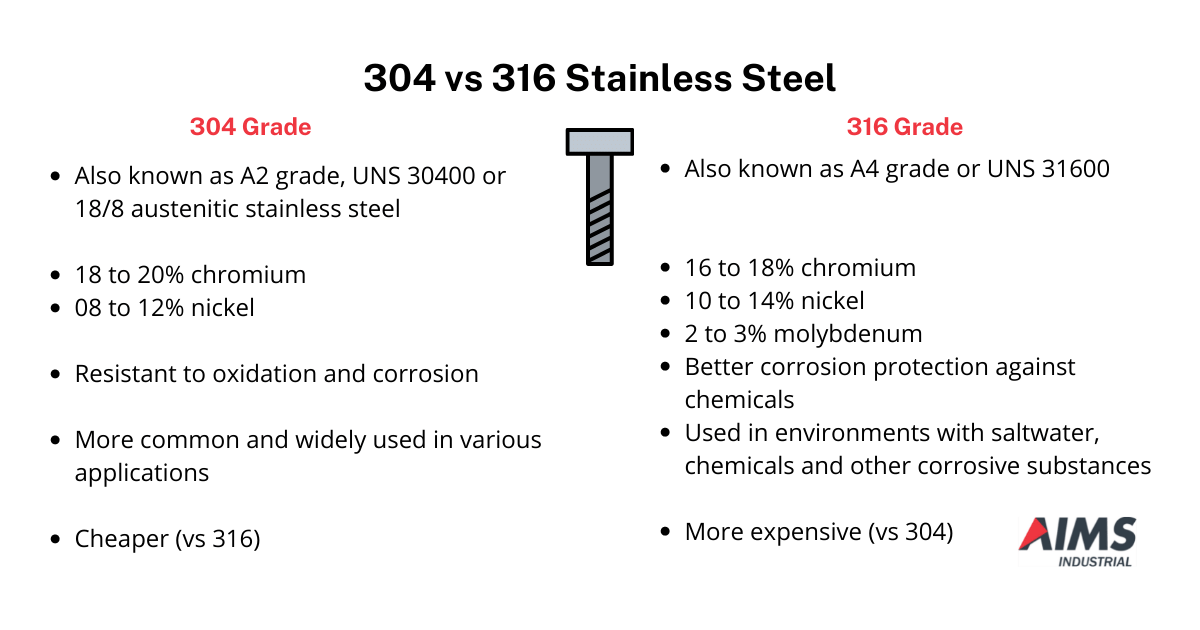
AIMS’ Note on Buying Industrial Supplies
- Breadth and depth of brands and categories: Go with a supplier that offers a wide range of reputable brands across multiple categories and sub-categories.
- Bulk purchase discounts: For large orders, check if you can take advantage of volume leverage. Some suppliers offer business accounts* that give you access to special pricing (volume discounts), preferential support and even credit eligibility (subject to supplier approval, terms and conditions).
- Product and service information: Evaluate the completeness and usefulness of data in their online product listings. Prudent suppliers will include as much useful information as possible to help you assess and compare products. In terms of service info, the supplier’s FAQs (if any) will give you a good idea of their standard policies*, processes and commitments.
- Promotions: Check for ongoing promotional campaigns so you can get the best prices. Many suppliers run regular discount-based promos. Some can point you to government-hosted rebate programmes like the SafeWork NSW $1000 Small Business Rebate.
- Safety compliance: Make sure the product in question meets Australian safety standards and regulations, especially if there are relevant compliance requirements or work health and safety (WHS) laws that apply to your business or state. Look for relevant certifications and markings where necessary.
- Supplier reliability: Choose reputable suppliers with a proven track record of delivering quality products and reliable customer service.
- Warranty and support: Check warranty terms and after-sales support* options, as this can be crucial in case of product defects or performance issues.
- Lead time and availability: Confirm product availability and estimated delivery times to avoid delays in your projects.
- Returns: Familiarise yourself with the suppliers returns and exchange policy in case you receive incorrect or damaged items.
- Delivery: Clarify delivery terms, including estimated delivery times, shipping costs and who handles insurance during transit (where applicable).
*Need help with a purchase decision? Contact us directly via chat or send an email to sales@aimsindustrial.com.au.
]]>.png)
It goes without saying that doing physical activities outdoors can be very taxing on the body, regardless of age, especially in the middle of the summer sun. The same is true when you’re working in a hot area (eg. in a bakery) or with equipment that involves heat (eg. metal forging and welding).
Moreover, the dangers of on-the-job dehydration are real, as detailed in this white paper.
Since we’re an industrial supplies store, we thought adding workplace hydration products would be a good idea. So, ever since we started selling Sqwinchers, we were asked these questions.
In this article, we answer some of them:
- How do I know when it’s time to rehydrate?
- I work indoors all the time, so I should be less dehydrated, right?
- Is Sqwincher better than water when it comes to hydration?
- Is Sqwincher better than Gatorade?
- Is Sqwincher an energy drink?
- Is Sqwincher better than coffee and tea?
- Is Sqwincher caffeine-free?
- Is Sqwincher sugar-free?
- Can I drink Sqwincher on an empty stomach?
- How many Sqwinchers can I drink in a day?
Disclaimer: AIMS is not a health expert, therefore the information provided herein should not be treated as medical advice.
How do I know when it’s time to rehydrate?
According to the white paper, the obvious symptoms are thirst and excessive perspiration / sweating, but the more subtle signs of mild to moderate dehydration include:
- Dark yellow urine (pale yellow indicates proper hydration levels)
- Dizziness / lightheadedness
- Dry skin
- Dry, sticky mouth
- Fatigue / tiredness
- Headache
- Less frequent urination
- Muscle cramps
- Constipation
In addition, there are a handful of key factors that contribute to dehydration:
- Environment (humidity, working in heat / under the sun, especially during summer)
- Physical activity
- Health conditions
- Diet
While the risk of dehydration increases for people doing strenuous activities under those conditions, that doesn’t mean you won’t easily get dehydrated when you work indoors or during colder weather.
Yes, hydration (especially in the workplace) is not just a summer issue, as Sqwincher explained in this Safeopedia article.
I work indoors all the time, so I should be less dehydrated, right?
That depends on the type of activity you are doing and the environment in which you work. Dehydration can also be a constant risk for people who work indoors, even during winter (but especially during summer). For instance, factory workers, restaurant kitchen workers and laundry service workers spend many working hours a day in hot environments.
Is Sqwincher better than water when it comes to hydration?
While humble drinking water will always be your “universal” thirst-quencher, there are some merits to choosing a Sqwincher over it. It is especially true if you need to re-hydrate quickly because what makes Sqwincher special is its formulation, which makes it easier and faster to be absorbed by the body than plain H2O.
That means it’s quicker to replenish the electrolytes you lost from all the sweating and hard work.
Is Sqwincher better than Gatorade?
We saw a page claiming that their “formulation is similar” and that "Sqwincher products do contain more electrolytes than Gatorade."
This press release from 2002 quoted the founder Mack Howard as saying: “It’s got half the sodium and twice the potassium of Gatorade. That’s one of the main things we’ve played on throughout the years.” We’ll take his word for it, although some of you will take it “with a grain of salt”. (Sorry!!)
We don’t think their “rivalry” is up there with Ferrari-vs-Lamborghini and Mustang-vs-Camaro, but surely both brands get the job done when it comes to hydration.
We’ve tried both products, and really, as with many things, it’s a matter of personal taste.
Is Sqwincher an energy drink?
That really depends on how you define “energy drink”, but if you refer to this Wikipedia entry based on Sqwincher’s website, their products are technically classified as “electrolyte beverages”. Regardless of what you want to call it, we think their witty slogan says it best: “Hydration That Works (At Work).
.png)
(We think that’s how you’re supposed to read it.)
Is Sqwincher better than coffee and tea?
Again, the answer here can be very subjective depending on one’s personal taste, but here are things to consider:
- You’re probably sweating in a hot work area or under the midday sun. Do you really need another hot beverage?
- Sqwincher contains “critical electrolytes” that you just can’t get from coffee and tea.
- Caffeine is a diuretic that makes you pee more, which could consequently make you more dehydrated (says page 5 of this white paper by Sqwincher themselves).
Is Sqwincher caffeine-free?
Speaking of caffeine, all Sqwincher beverages that you can buy from our store are caffeine-free. Most of them are low in sodium and gluten-free, too.
Is Sqwincher sugar-free?
A lot of Sqwincher products list sugar as an ingredient, but we sell sugar-free options such as these convenient Qwik Sticks and Squeeze Pops.
Can I drink Sqwincher on an empty stomach?
It’s generally not advisable to do so.
How many Sqwinchers can I drink in a day?
We found no conclusive research suggesting you can’t drink more than one serving in a day, although it’s best to err on the side of caution, especially if you have pre-existing conditions that require extra care.
That’s all for now. We’ll keep on updating this list as we receive more questions.
AIMS’ Note on Buying Industrial Supplies
- Breadth and depth of brands and categories: Go with a supplier that offers a wide range of reputable brands across multiple categories and sub-categories.
- Bulk purchase discounts: For large orders, check if you can take advantage of volume leverage. Some suppliers offer business accounts* that give you access to special pricing (volume discounts), preferential support and even credit eligibility (subject to supplier approval, terms and conditions).
- Product and service information: Evaluate the completeness and usefulness of data in their online product listings. Prudent suppliers will include as much useful information as possible to help you assess and compare products. In terms of service info, the supplier’s FAQs (if any) will give you a good idea of their standard policies*, processes and commitments.
- Promotions: Check for ongoing promotional campaigns so you can get the best prices. Many suppliers run regular discount-based promos. Some can point you to government-hosted rebate programmes like the SafeWork NSW $1000 Small Business Rebate.
- Safety compliance: Make sure the product in question meets Australian safety standards and regulations, especially if there are relevant compliance requirements or work health and safety (WHS) laws that apply to your business or state. Look for relevant certifications and markings where necessary.
- Supplier reliability: Choose reputable suppliers with a proven track record of delivering quality products and reliable customer service.
- Warranty and support: Check warranty terms and after-sales support* options, as this can be crucial in case of product defects or performance issues.
- Lead time and availability: Confirm product availability and estimated delivery times to avoid delays in your projects.
- Returns: Familiarise yourself with the suppliers returns and exchange policy in case you receive incorrect or damaged items.
- Delivery: Clarify delivery terms, including estimated delivery times, shipping costs and who handles insurance during transit (where applicable).
*Need help with a purchase decision? Contact us directly via chat or send an email to sales@aimsindustrial.com.au.
]]>.png)
- Are anti-slip solutions mandated by law?
- Specific standards for different flooring surfaces
- Common slip hazards
- Common trip hazards
- Which floor types (surfaces) need anti-slip solutions
- Where to use anti-slip products
- More anti-slip FAQs
Are anti-slip solutions mandated by law?
When it comes to slip resistance compliance, always err on the side of caution.
If these work health and safety (WHS) statistics fail to convince you to install anti-slip solutions where your staff and customers walk, perhaps your legal duties will.
Yes, as a business owner, you have a general duty of care. Put simply, you have WHS responsibilities.
As we’ve emphasized in our slip resistance compliance guide:
Slipping, tripping and falling are risks that can be associated with steps and stairs, and can lead to serious injuries. Under the WHS Act, the employer has a ‘duty of care’ to provide and maintain a safe and healthy workplace – all potential hazards must be identified, the associated risks assessed and then controls introduced to eliminate or reduce those risks as far as practicable.
(Make sure to get your free copy of the guide here.)
Your responsibility extends to making sure your customers, visitors, and any contractors are safe at your business premises.
It is prescribed by Australian Standard AS1428.1 and a mandatory compliance requirement under the Building Code of Australia.
Disclaimer: AIMS is not a WHS law expert, therefore the information provided here should be treated as general in nature and not be treated as specific, legal or professional advice. Our article about WHS laws only aims to compile resources that may be helpful to your business. Official sources of information are cited.
Specific standards for different flooring surfaces
Standards Australia has a compilation of the prescribed minimum slip resistance requirements for different flooring surfaces.
Here are the links for your convenience:
Common slip and trip hazards
You can refer to this comprehensive fact sheet from Safe Work Australia (SWA) when trying to identify what may possibly cause a slip or trip accident.
For your convenience, we’ve simplified SWA’s list below.
- Spills of liquid or solid material
- Wet cleaning methods
- Wind-driven rain or snow through doorways
- Sudden change in floor surface (eg. joins between carpet and polished timber)
- Change from a wet to a dry surface
- Dusty and sandy surfaces
- Ramp incline
- Bumpy/Loose flooring
- Poor lighting
- Use of unsuitable footwear
- Ridges in floors or carpets
- Worn floor coverings
- Broken tiles
- Cracks and potholes in floors
- Changes in floor level
- Thresholds and doorstops
- Floor sockets and phone jacks
- Cables from power extension units
- Loads that obstruct vision
- Obstacles in traffic areas
For more information, be sure to read our article about how you can prevent slips, trips and falls in the workplace.
Which floor types (surfaces) need anti-slip solutions
SWA’s fact sheet has a quick guide to help you figure out which kinds of surfaces get slippery in what situation:
| Floor Type | Characteristics |
|
Concrete |
Rounded aggregate can be slippery when concrete wears. Interior surface is often sealed to prevent dusting and absorption of liquids - this can increase slipperiness. |
|
Terrazzo |
Gives good appearance and wears well but can be slippery when wet, when excess polish is used or when dusty. |
|
Quarry tiles, ceramic tiles |
Low water absorption and good resistance to chemicals. Slippery in wet conditions if smooth, but can be moulded with aggregate or profiles to improve slip resistance - special cleaning equipment may then be required. |
|
Glazed ceramic tiles |
Slippery when wet, particularly with soapy water. Some slip resistance treatments available, but preferable not to install these tiles on floors. |
|
Vinyl tiles and sheet |
Easy to clean. Use sheet form where frequent washing is required to avoid water getting under tiles. Slippery when wet, particularly if polished, however slip resistant vinyls are available. These have aggregates moulded in. Thicker and softer vinyls are more slip resistant than hard ones. |
| Cork |
Must be sealed to prevent absorption of oil and water, but may then be slippery when wet. |
| Steel plate |
Tends to be slippery when wet or oily, particularly when worn. |
| Rubber |
Less effective in wet conditions. Must be fixed down well at the edges and joints or will cause a trip hazard. |
| Plastic matting |
Interlocking PVC extrusions give good drainage and slip resistance. Hose down or steam clean. |
| Carpet |
Carpet has a shorter life than hard floor surfaces, but it can be a cost-effective solution. Installations should be wall to wall, to avoid the hazard of a trip on edges. When used in small local areas, such as at entrances, it should be installed in a recess in the floor. Alternatively, it should be rubber-backed and with hardwearing tapered edges. Trolleys can be harder to push on carpet, but if larger wheels are fitted and the carpet does not have a deep pile, this is not a serious problem. |
| Fiberglass gratings |
This product can have grit particles moulded into upper surface to provide very good slip resistance. Fluids are quickly drained away. |
Where to use anti-slip products
Standard anti-slip products are installed in relatively familiar pedestrian locations:
- Ladders rungs: The mostly smooth and often small foot surface area on ladder rungs present an extremely high-risk hazard that needs to be made safe by being covered with anti-slip material as specified in AS1657. Here are more reasons why ladder rung covers are essential for safety.
- Landings, platforms, ramps and walkways: Even flat surfaces can become slippery when left oily, overly polished or wet. That's where you need safeplates to ensure firm footing.
- Steps, stairs and stairwells: Slips, trips and falls on stairways are a more common occurrence in industrial and commercial environments than they should be, sharing about the same frequency of incidents being reported. Consider installing stair nosings in those places. There are even commercial grade ones for surfaces such as ceramic, concrete and masonry.
- Conveyor channel cleats: Slip-proof these surfaces with cleats that provide firm footing on most types of grating mesh conveyor ramps, platforms or walkways (even those with a sharp incline).
You’ve probably even seen anti-slip products during your daily routine and haven't really noticed them placed on:
- Transport and logistics vehicles
- Trains and station platforms
- Emergency service vehicles
- Construction and mining machinery
- Food production equipment
- Weighbridges
- Skateboards
They’re even on infrastructure projects, such as:
- Bridges
- Dams
- Tunnels
Anti-slip products are also widely used in various areas in civil aviation and the agriculture sector.
We’re guessing there’s a big chance you’ll need an anti-slip solution for your business.
In the meantime, here are some easy things that you can do quickly to prevent slips:
More anti-slip FAQs
The safe surfaces industry is one of the most important sectors in the safety market for protecting workers, visitors, contractors and all pedestrians from incident and injury due to a slip, trip, stumble, tumble or a fall.
Anti-slip products come in a wide variety of shapes, sizes, colours, coarseness grades and are required to achieve a multitude of different results, such as:
- Safety
- Compliance requirements
- Visibility
- Aesthetic
- Covering of an aging or worn surface
Do you need different kinds of anti-slip for indoor and outdoor use?
Primarily, you will consider the level of safety that the anti-slip product can provide. There are instances where indoors is harsher and has more slip hazards, especially in workplaces where floors often get liquid spills. In this case, the level of coarseness will make all the difference.
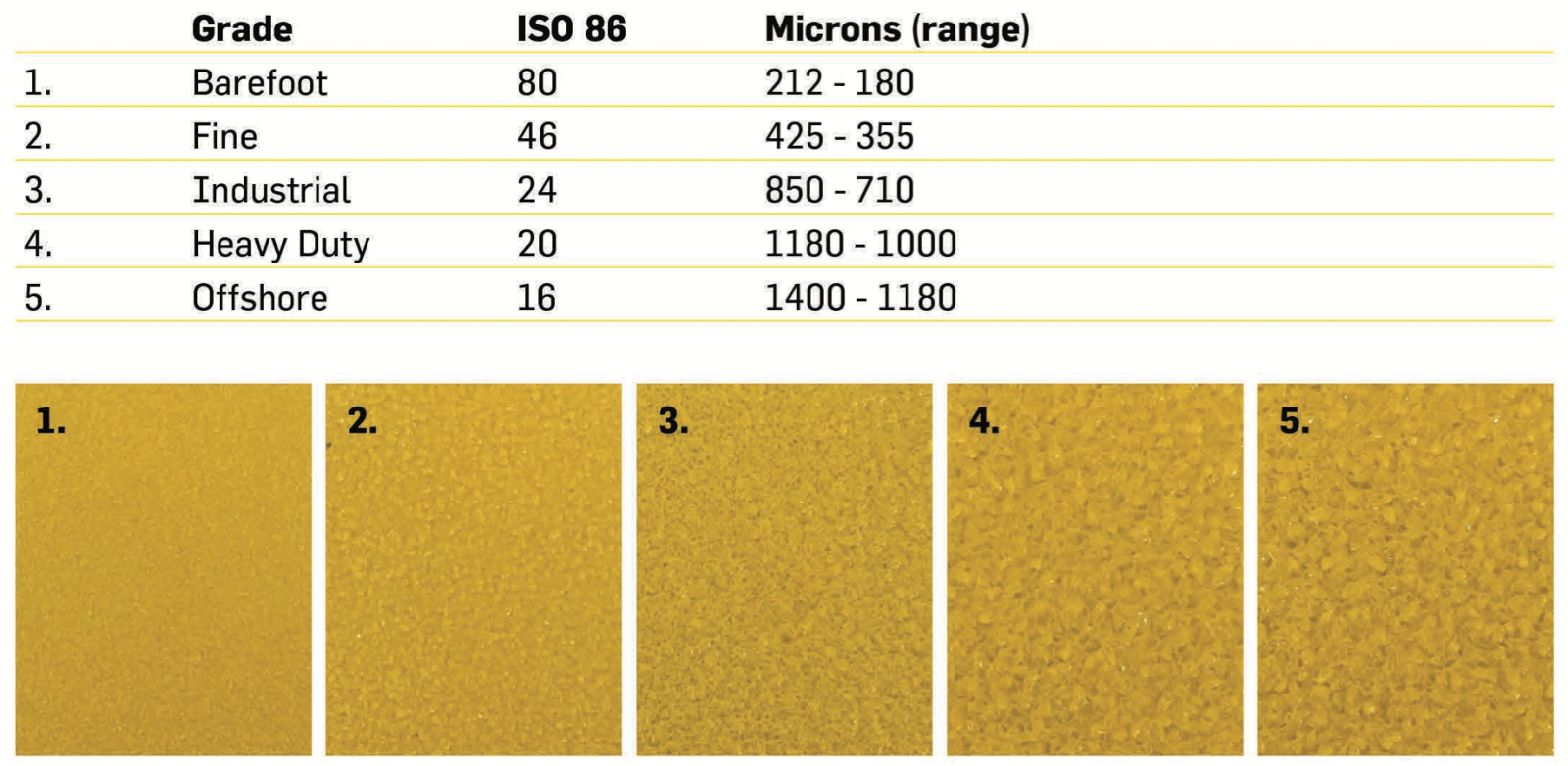
Which level of coarseness (grade) is right for my intended use?
Consider the types of pedestrians that need to be kept safe from a possible slip, stumble, trip, tumble, falter or fall.
|
Grade |
Generally used in |
|
Barefoot – 80 ISO (86) |
Areas where people may walk around in bare feet or in open-toed footwear, and there is no excess buildup of dirt, dust or debris, such as in child care centres, playground areas, picnic grounds and community pools
|
|
Fine – 46 ISO (86) |
|
|
Industrial – 24 ISO (86) |
Commercial or light industrial applications where an increased level of safety is required, such as at educational institutions, walkways and ramps for people with a disability, some residential applications and public transport infrastructure |
|
Heavy Duty – 20 ISO (86) |
Industrial applications where workers and visitors need a superior level of safety when traversing all types of pedestrian access areas, due to the possibility of an excess of dirt, dust, debris or spillage of product in trafficked areas around the workplace |
|
Offshore – 16 ISO (86) |
Applications where there is a high accumulation of, or the presence of carbon greases, heavy oils, or increased spillages on a stairway, walkway, platform or landing need the highest level of safety surface |
When installed to manufacturer guidance, standard metal-backed anti-slip products would generally have beads of silicone adhesive applied to bond the metal to the substrate. That, in addition to a layer of laminated material and resin coating, makes the product safe from potential electrical/static conduction, according to Advance Antislip Solutions.
What are your anti-slip products made of?
According to Advance Anti-Slip Surfaces, their main range of anti-slip, metal-backed products are made from high quality, BlueScope sheet products such as Colorbond®, Galvabond®, as well as 5052 aluminium and 316 stainless steel. They also offer anti-slip tapes.
Do they corrode and rust?
The sealed surface is unlikely to corrode or rust. It’s because the foundation elements are machine pressed, sheer cut from sheet steel, and the edges are coated and sealed to protect the metal.
What about anti-slip coatings?
Applied anti-slip floor coating and slip-resistant coating products have their place in the safe surfaces industry, especially where there are extremely large square metreage areas that need to be made safe for pedestrians. They are initially very effective at preventing slips and falls; however (over time and with lots of machine cleaning), they will wear away and need resurfacing at regular intervals. They also need a lot of time to dry before pedestrians can access the area.
What kinds of liquid can your anti-slip products “resist”?
They are resistant to most solvents, petroleum products and acid solutions. High concentrations of chemical, alkali, acid, solvent or other liquid contaminant (that may be harmful to humans even when wearing safety boots with slip-resistant soles) could have an effect on the product’s hardened resin coating. Although so far, we haven’t come across an instance where the products have succumbed to such a liquid contaminant attack.
How do I keep the anti-slip products clean?
You can use a firm bristle brush/broom and mops to clean them. You can even spray them with pressurized water, too (if that’s part of your housekeeping SOP). Most readily available surfactant-based detergents can clean the non-slip surface well enough, and most diluted cleaning chemicals clean the anti-slip surface without affecting its integrity.
Avoid acid-based cleaning chemicals with high concentrations of acidic components.
What are the available colours?
You can choose from our standard colour range chart. The most popular is Safety Yellow. We also offer “higher visibility” photo-luminescent (glow in the dark) Safety Yellow, Nano Green and Safety Red.
Can I relocate (reuse) the products to a different location/surface later on?
Relocating or repositioning a previously installed metal-backed anti-slip product is possible if it is removed from its existing location without sustaining any damage. If you intend to reposition them on a similar surface, there should be no potential issues, although a quick check with us to confirm the details might be wise.
AIMS’ Note on Buying Industrial Supplies
- Breadth and depth of brands and categories: Go with a supplier that offers a wide range of reputable brands across multiple categories and sub-categories.
- Bulk purchase discounts: For large orders, check if you can take advantage of volume leverage. Some suppliers offer business accounts* that give you access to special pricing (volume discounts), preferential support and even credit eligibility (subject to supplier approval, terms and conditions).
- Product and service information: Evaluate the completeness and usefulness of data in their online product listings. Prudent suppliers will include as much useful information as possible to help you assess and compare products. In terms of service info, the supplier’s FAQs (if any) will give you a good idea of their standard policies*, processes and commitments.
- Promotions: Check for ongoing promotional campaigns so you can get the best prices. Many suppliers run regular discount-based promos. Some can point you to government-hosted rebate programmes like the SafeWork NSW $1000 Small Business Rebate.
- Safety compliance: Make sure the product in question meets Australian safety standards and regulations, especially if there are relevant compliance requirements or work health and safety (WHS) laws that apply to your business or state. Look for relevant certifications and markings where necessary.
- Supplier reliability: Choose reputable suppliers with a proven track record of delivering quality products and reliable customer service.
- Warranty and support: Check warranty terms and after-sales support* options, as this can be crucial in case of product defects or performance issues.
- Lead time and availability: Confirm product availability and estimated delivery times to avoid delays in your projects.
- Returns: Familiarise yourself with the suppliers returns and exchange policy in case you receive incorrect or damaged items.
- Delivery: Clarify delivery terms, including estimated delivery times, shipping costs and who handles insurance during transit (where applicable).
*Need help with a purchase decision? Contact us directly via chat or send an email to sales@aimsindustrial.com.au.
]]>
.png)
Castors (or ‘casters’) make it easy to move things around. You usually see them in an industrial setting installed on your heavy equipment and material handling tools, such as:
- Dollies, pallet jacks and trolleys
- Mobile parts washers (like the CRC SW-37 Heavy-Duty Mobile Heavyweight Parts Washer)
- Mobile workbenches and workstations
- Table carts
- Vacuum cleaners
Moreover, there are models designed for use on hospital beds and medical equipment, such as these examples from Colson, EasyRoll and Rhombus. There are even light-duty ones for light furniture such as these ones from MoveIt.
Unlike regular wheels, castors are different because:
- They may swivel via a metal frame called a fork or yoke that allows them to rotate in different directions without making the whole object turn. Some castors are even designed to lock at certain angles for stability.
- They come in different materials like rubber, plastic or metal, depending on what they are designed to roll on to (eg smooth floors, rail, rough terrain etc).
Basically, anything that needs to be moved easily and efficiently will likely have some trusty castors beneath it. They are generally sturdy, but there will be signs when it’s time to replace them.
Choosing the right castor
So, it’s time to buy new castors. These factors are crucial for ensuring smooth movement and safety for your intended application:
- Load capacity: This is probably the most important factor, so make sure the castors can support the weight of the object you will be using them on. They are typically rated for a certain weight capacity, so be sure to choose ones that exceed the weight of your object. You don’t want to cheap out on this one, or you riski a scenario where the castor breaks during a critical time or while carrying a heavy load.
Note: The weight capacity rating is per castor. So, for example, assuming the castors are mounted such that weight is evenly distributed, four similar 50-kg rated castors can collectively hold up to 200-kg of load. It would be wise to play it safe and over-specify a little, so in this case get 60-kg or 70-kg rated castors (instead of 50-kg's).
Bottom line: Do not ever overload your castors!
- Wheel material: Speaking of rolling resistance, you want to choose the type of wheel material wisely. The right material -- solid rubber, pneumatic, polyurethane, nylon, iron, steel etc -- will depend on the surface you will be using them on.
For example, castors with soft rubber wheels are good for hard floors, while hard plastic wheels are good for soft floors. You should also consider the temperature and chemicals that the wheels will be exposed to.
- Solid rubber wheels are the most common type, and they are suitable for most indoor applications.
- Pneumatic wheels have air-filled tires that provide good shock absorption, and they are ideal for uneven surfaces.
- They are much like car tires in that they have an inflatable air chamber and rubber tread.
- Polyurethane wheels are strong and durable, and they can be used on a variety of surfaces.
- Metal wheels are often used in industrial applications where heavy loads need to be moved.
Furthermore, keep in mind that there are other external variables that can affect rolling resistance, namely:
- The condition of the castor
- The condition, material and slope of the floor, including the presence of debris or slippery substances
Bottom line: Wheel material matters, as it significantly affects rolling resistance.
Pro tip: If rolling noise is a concern, then you may want to go with rubber and polyurethane wheels.
- Wheel diameter: Larger wheels offer better stability and handle rougher surfaces better, but smaller wheels are often more maneuverable in tight spaces.
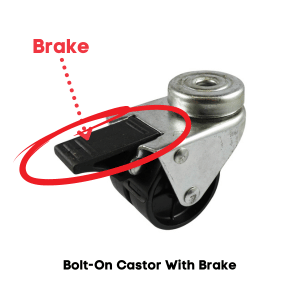 Swiveling or locking: Decide if you need fixed (rigid) castors for straight-line movement or swiveling castors for turning. Double swivels offer maximum maneuverability. On the other hand, consider castors with brakes for when stopping and holding the load in place is crucial.
Swiveling or locking: Decide if you need fixed (rigid) castors for straight-line movement or swiveling castors for turning. Double swivels offer maximum maneuverability. On the other hand, consider castors with brakes for when stopping and holding the load in place is crucial.
- Bearing type: Ball bearings offer smooth rolling and are good for light loads, while roller bearings can handle heavier loads. Sealed bearings require less maintenance and are better for dusty or wet environments. It would be wise to choose those with bearings that you can easily lubricate and replace.
- Mounting type: Choose the mounting type compatible with your equipment. Typical options include bolt-on / bolt hole mount, plate mount and stem mount.
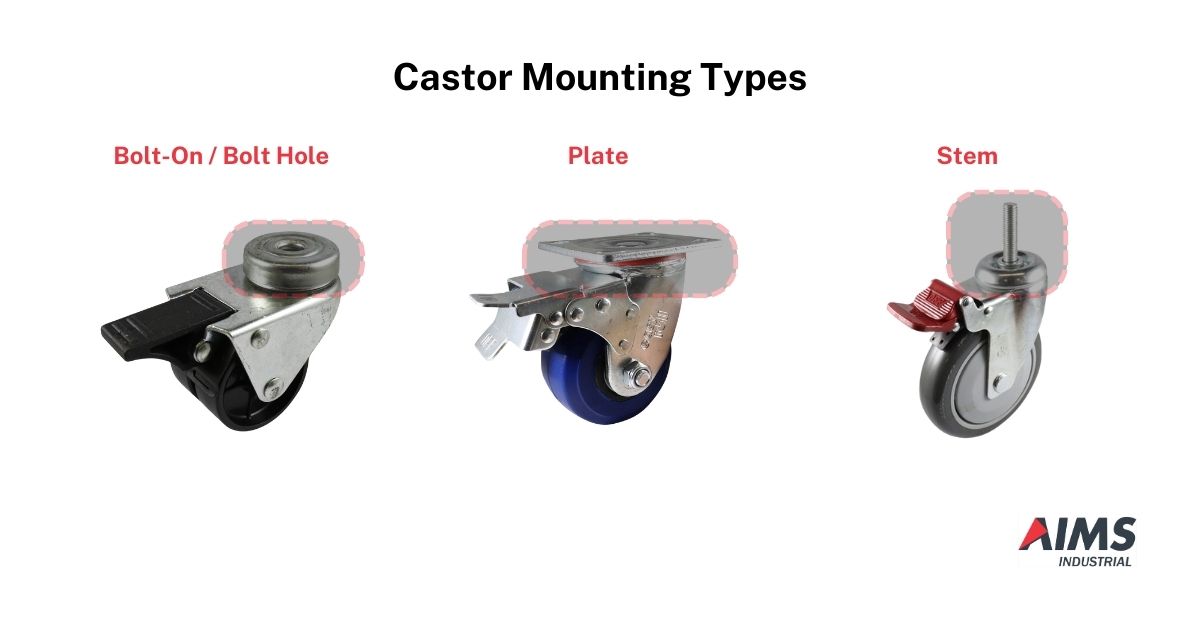
How do you know when it’s time to replace your castors?
Visible damage:
- Cracks, chips, or breaks: Look for any visible damage to the wheels or housing of the castor. This could be caused by overloading, impact, or exposure to harsh environments.
- Flat spots or uneven wear: If the wheels are no longer round or are wearing unevenly, they won't roll smoothly and should be replaced.
- Corrosion: Check for rust or other signs of corrosion on the metal parts of the castor. This can weaken the structure and make them more likely to break.
- Loose bearings: If the wheels wobble or have excessive play, the bearings may be worn or damaged. Loose bearings can also lead to noise and decreased maneuverability.
Performance:
- Difficulty rolling: If the castors are stiff or difficult to push, it could be a sign of worn bearings, flat spots, or damage to the wheels.
- Excessive noise: Squeaking, grinding, or other loud noises can indicate worn bearings, damaged wheels, or improper alignment.
- Uneven movement: If the castors don't swivel smoothly or track properly, it could be due to worn bearings, damage, or a loose mounting.
Usage:
- Castors used in demanding applications and environments -- such as heavy loads, uneven surfaces, exposure to chemicals -- will wear out faster than those used in light-duty applications.
Manufacturer recommendations:
- Many recommend replacing them after a certain period of time or number of cycles.
By being proactive about castor maintenance and replacement, you can prevent accidents and extend the life of your equipment.
AIMS’ Note on Buying Industrial Supplies
- Breadth and depth of brands and categories: Go with a supplier that offers a wide range of reputable brands across multiple categories and sub-categories.
- Bulk purchase discounts: For large orders, check if you can take advantage of volume leverage. Some suppliers offer business accounts* that give you access to special pricing (volume discounts), preferential support and even credit eligibility (subject to supplier approval, terms and conditions).
- Product and service information: Evaluate the completeness and usefulness of data in their online product listings. Prudent suppliers will include as much useful information as possible to help you assess and compare products. In terms of service info, the supplier’s FAQs (if any) will give you a good idea of their standard policies*, processes and commitments.
- Promotions: Check for ongoing promotional campaigns so you can get the best prices. Many suppliers run regular discount-based promos. Some can point you to government-hosted rebate programmes like the SafeWork NSW $1000 Small Business Rebate.
- Safety compliance: Make sure the product in question meets Australian safety standards and regulations, especially if there are relevant compliance requirements or work health and safety (WHS) laws that apply to your business or state. Look for relevant certifications and markings where necessary.
- Supplier reliability: Choose reputable suppliers with a proven track record of delivering quality products and reliable customer service.
- Warranty and support: Check warranty terms and after-sales support* options, as this can be crucial in case of product defects or performance issues.
- Lead time and availability: Confirm product availability and estimated delivery times to avoid delays in your projects.
- Returns: Familiarise yourself with the suppliers returns and exchange policy in case you receive incorrect or damaged items.
- Delivery: Clarify delivery terms, including estimated delivery times, shipping costs and who handles insurance during transit (where applicable).
*Need help with a purchase decision? Contact us directly via chat or send an email to sales@aimsindustrial.com.au.
]]>.png)
In this article, we answer these questions:
- What are the key hazards associated with welding?
- What is the Australian Standard for welding safety?
- What are the primary control measures for welding hazards?
- What PPE is needed for welding?
- What is the Workplace Exposure Standard (WES) for welding fume in Australia?
- How bad can welding fumes be?
- How bad can flash burns be?
- What are my responsibilities for welding safety?
- Are there specific safe welding codes of practice per state?
What are the key hazards associated with welding?
Here are the most common ones:
- Fumes and harmful gases: Welding generates fumes that can contain harmful (and even cancerous) substances and inhaling them can lead to short and long-term health issues, including respiratory problems and potential cancers.
- Electric shock: Welding equipment uses electricity, thereby posing a risk of electric shock, particularly in damp or wet conditions. Faulty equipment or improper grounding also increases this risk.
- Burns: The welding arc, sparks and hot metal can cause severe burns, so best make sure to wear PPE properly.
- Eye injuries: UV and infrared radiation from the welding arc can damage eyes, leading to conditions such as "arc eye" (aka flash burns) or permanent vision loss.
- Fire and explosions: Welding sparks can ignite flammable materials, particularly in some welding processes that use flammable gases.
What is the Australian Standard for welding safety?
AS/NZS 1764 provides the overarching framework for welding safety in Australia, including requirements for risk assessment, hazard control and worker training. Specifically:
- AS/NZS 1674.1:1997 Safety in welding and allied processes – Part 1: Fire precautions is the current designation that outlines specific safety guidelines for welding and similar processes that pose fire and explosion risks. It emphasizes a hierarchy of control measures to minimise risk, namely elimination/substitution, isolation, engineering and administrative controls and personal protective equipment (PPE).
- AS/NZS 1674.2:2007 Safety in welding and allied processes – Part 2: Electrical is the current designation that outlines specific safety guidelines for welding and similar processes that pose electrical hazards.
Other relevant standards:
- AS/NZS 1338.1:2012 Filters for eye protectors, Part 1: Filters for protection against radiation generated in welding and allied operations covers the shade recommendations for welding helmets relevant to the welding process.
- Safe Work Australia Codes of Practice: Specific codes of practice exist for managing welding processes, hazardous chemicals, noise and confined spaces, all of which are relevant to welding safety. Refer to the full text of SWA’s Model Code of Practice on Welding Processes for more comprehensive information.
What are the primary control measures for welding hazards?
According to SWA’s Model Code of Practice on Welding Processes (published July 2020, that is the most recent version to date), businesses can manage the risks associated with welding by implementing these control measures wherever possible:
- Elimination and substitution: Do away with welding altogether or at least substitute the activity with a less hazardous process. For instance, fabrications may include pre-cast components or extruded shapes to eliminate the need to weld. Bolting is another (more common) alternative to welding.
- Isolation: Limit how much contact people have with the hazard by moving the work to a separate remote location, or at least by using barriers (such as these welding blankets and curtains) to block off the dangerous area.
- Engineering controls: Implement physical modifications to the workspace that are designed to minimise risk, such as local exhaust ventilation (LEV) systems to capture the fume at its source.
- Administrative controls: Consider implementing changes to work procedures that are designed help reduce danger. Some suggestions include (1) limit welding time, (2) rotating welders and (3) allowing for frequent breaks to lower the welder’s risk of heat exhaustion (more on working in heat in this article). Of course, those are on top of the adequate training and compliance to safe work procedures that are expected of you.
- PPE: Mandate the use of appropriate respiratory protection, welding helmets, protective clothing and gloves. In some instances, the welder may have to stand on metallic surfaces which form part of the electric circuit that may become ‘live’, so making them wear work shoes with electrical hazard protection will reduce the risk of electric shock.
Important: Administrative controls and PPE are reactive and do not eliminate the hazard itself, and they heavily depend on people to follow rules and wear the right gear.
What PPE is needed for welding?
Here is a more complete list of safety wearables on top of the examples we provided above:
- Welding clothing: They are specially made to protect the body from sparks and heat, and many of them are made of flame-retardant materials. You can choose from a variety of welder’s jackets. At the minimum, at least wear some leather sleeves and full aprons to protect your skin from spatter. Snoods also work to protect the head and neck.
- Welding gloves: They are designed to protect your hands from burns / flames / heat, electrical shocks / sparks and ultraviolet rays from the welding process.
- Welding goggles and face shields: They protect your eyes from the dangers of welding, including heat, sparks and harmful radiation. The googles use dark lenses, rated by shade number, to let you see your work safely. Higher shade numbers mean darker lenses and more protection. In addition, welding face shields are extra protection worn over goggles. They have clear visors to shield your face from sparks and debris during welding and similar tasks.
- Welding helmets: They protect your eyes and face from arc radiation, sparks and debris. You can choose between auto-darkening and fixed shade variants. Choose one with the appropriate level of shade for the welding process and a wide viewing area for optimum convenience. Accessories and supplementary parts are also available to help you keep them in top shape.
- Respiratory protection: They prevent workers from inhaling airborne hazardous substances. A secure fit is vital for preventing leaks.
Pro tip: You can also use anti-spatters to, well, reduce spatter and get cleaner welds.
What is the Workplace Exposure Standard (WES) for welding fume in Australia?
In January 2024, Safe Work Australia (SWA) announced that “Work Health and Safety Ministers have agreed to an immediate reduction to the workplace exposure standard (WES) for welding fumes (not otherwise classified) has been reduced from an 8-hour time weighted average (TWA) of 5 mg / m3 to 1 mg / m3.”
- Such a reduction is believed to better protect workers from the adverse health effects associated with welding fumes, such as lung cancer.
- This stricter standard requires a revision of risk assessments and implementation of additional ventilation and respiratory protection measures.
How bad can welding fumes be?
According to SafeWork NSW, in 2017 the International Agency for Research on Cancer (IARC), a part of the World Health Organization, found enough evidence to declare welding fumes a definite cause of cancer. They also classified UV radiation from welding as a cancer-causing agent for the first time.
Welding fumes are full of particles you obviously don’t want to inhale:
- Tiny metal pieces: Welding fumes are full of microscopic bits of the metal you’re working with during welding. Think beryllium, chromium, cadmium, manganese, nickel and the like.
- Dangerous gases: Welding also releases gases -- such as ozone, nitrogen oxides and even carbon monoxide – that can irritate your airways or be seriously poisonous.
You don’t want to deal with these health problems, especially #4 onwards which have long-term negative effects:
- Breathing troubles such as coughing, wheezing and trouble catching your breath
- Irritated eyes and skin that make it hard for you to function properly and focus on the task at hand
- Metal fume fever that makes you feel achy and sick like you have the flu
- Compromised lungs that generally weaken your immunity and make it harder for you to breathe
- Brain problems caused by inhaled manganese that may cause symptoms similar to Parkinson's Disease
- Cancers (usually of the lung, kidney and the larynx / voice box, but there could be more) that everybody wants to avoid
Pro tip: Refer to this informative fact sheet (with a snapshot below) by The Cancer Council to learn more about the occupational cancer risks of welding:
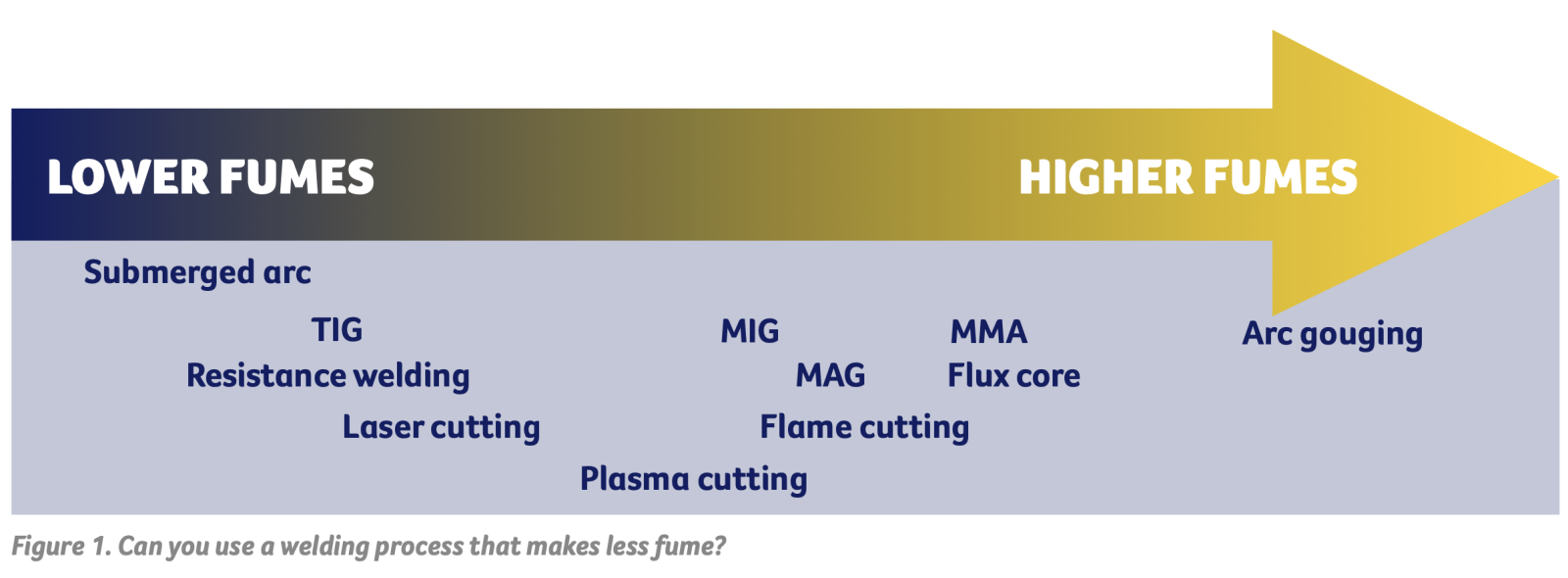
Note: The specific type of welding process, metals involved and ventilation in the workplace all influence the risk level. So do individual factors like genetics and smoking habits that make some people more susceptible to the carcinogenic effects of welding fumes.
How bad can flash burns be?
Arc eye or flash burns, also known as photokeratitis, can range from mildly uncomfortable to extremely painful and potentially dangerous.
It’s also sometimes referred to as welder’s flash, and it is often caused by the bright light and UV rays from welding, so make sure to wear welding goggles at the minimum.
According to a Queensland Health Emergency Department fact sheet, it feels like having grit in your eyes with the following symptoms:
- Pain that may be mild to very severe
- Bloodshot eyes
- Being sensitive to light
- Watery eyes
- Blurred vision
Better Health Channel by Victoria’s Department of Health indicates that treatment could involve:
- Eye drops
- Coverings to rest your eyes
- Cool packs
- Artificial tears
- Antibiotics
Important: While mild cases get better on their own, severe ones need immediate medical attention to prevent complications like temporary vision loss or infection.
What are my responsibilities for welding safety?
That heavily depends on your role, but always keep in mind that safety is always a shared responsibility.
Employers and Persons Conducting Business Undertakings (PCBUs)
- Primary duty of care: You ensure the health and safety of all workers and others who might be affected by the work.
- Provide a safe workplace: This includes safe systems of work, appropriate equipment that is well-maintained and a suitable work environment.
- Manage risks: You must conduct thorough risk assessments for welding operations, implement the control measures mentioned above (and then some) and regularly review them to make sure they are ever relevant to your current circumstances. This includes processing of hot work permits.
- Information, training, instruction and supervision: Provide comprehensive training on welding procedures, hazard identification, safe use of equipment and emergency responses. Ensure workers are adequately supervised.
- Consultation: Actively involve workers in identifying hazards and developing safety solutions.
- Risk assessments: Conduct thorough risk assessments of all welding operations.
- Safe Work Procedures: Develop and enforce clear procedures for safe welding.
- Equipment Maintenance: Maintain welding equipment in good condition.
- Emergency Plans: Prepare for welding-related emergencies (fires, explosions, injuries).
Workers
- Take reasonable care: Protect your own health and safety and that of others.
- Follow safety procedures: Adhere to established work practices and instructions provided by your employer.
- Wear and use PPE correctly: Make sure you use them appropriately and they fit you properly.
- Report hazards and incidents: Immediately notify your supervisor about any safety concerns, near-misses or accidents so they can immediately be reviewed, and their risks mitigated so they can immediately be reviewed, and their risks mitigated
- Participate in safety initiatives: Actively engage in training, risk assessments and safety discussions.
Are there specific safe welding codes of practice per state?
We compiled these links based on current information (as of March 2024):
New South Wales:
Northern Territory:
- https://ablis.business.gov.au/service/nt/welding-processes-code-of-practice/46263
- https://worksafe.nt.gov.au/forms-and-resources/codes-of-practice/welding-processes2
Queensland:
- https://ablis.business.gov.au/service/qld/welding-processes-code-of-practice-2021/42275
- https://www.worksafe.qld.gov.au/safety-and-prevention/hazards/hazardous-exposures/welding
Western Australia:
- https://ablis.business.gov.au/service/wa/australian-standard-as-1674-safety-in-welding-and-allied-processes/17568
- https://www.commerce.wa.gov.au/publications/code-practice-welding-processes
South Australia:
- https://ablis.business.gov.au/service/sa/welding-processes-code-of-practice/43568
- https://www.safework.sa.gov.au/workplaces/work-tasks-and-projects/welding
Tasmania:
- https://ablis.business.gov.au/service/tas/welding-processes-code-of-practice/31087
- https://worksafe.tas.gov.au/__data/assets/pdf_file/0020/537131/Code-of-Practice-Welding-processes.pdf
- https://worksafe.tas.gov.au/topics/laws-and-compliance/codes-of-practice/cop-folder/welding-processes
Victoria:
AIMS’ Note on Buying Industrial Supplies
- Breadth and depth of brands and categories: Go with a supplier that offers a wide range of reputable brands across multiple categories and sub-categories.
- Bulk purchase discounts: For large orders, check if you can take advantage of volume leverage. Some suppliers offer business accounts* that give you access to special pricing (volume discounts), preferential support and even credit eligibility (subject to supplier approval, terms and conditions).
- Product and service information: Evaluate the completeness and usefulness of data in their online product listings. Prudent suppliers will include as much useful information as possible to help you assess and compare products. In terms of service info, the supplier’s FAQs (if any) will give you a good idea of their standard policies*, processes and commitments.
- Promotions: Check for ongoing promotional campaigns so you can get the best prices. Many suppliers run regular discount-based promos. Some can point you to government-hosted rebate programmes like the SafeWork NSW $1000 Small Business Rebate.
- Safety compliance: Make sure the product in question meets Australian safety standards and regulations, especially if there are relevant compliance requirements or work health and safety (WHS) laws that apply to your business or state. Look for relevant certifications and markings where necessary.
- Supplier reliability: Choose reputable suppliers with a proven track record of delivering quality products and reliable customer service.
- Warranty and support: Check warranty terms and after-sales support* options, as this can be crucial in case of product defects or performance issues.
- Lead time and availability: Confirm product availability and estimated delivery times to avoid delays in your projects.
- Returns: Familiarise yourself with the suppliers returns and exchange policy in case you receive incorrect or damaged items.
- Delivery: Clarify delivery terms, including estimated delivery times, shipping costs and who handles insurance during transit (where applicable).
*Need help with a purchase decision? Contact us directly via chat or send an email to sales@aimsindustrial.com.au.
]]>.png)
- What is economic order quantity (EOQ)?
- The EOQ Formula
- Key considerations when using EOQ
- Additional benefits of using EOQ
What is economic order quantity (EOQ)?
EOQ is the ideal order size that a company should purchase to minimise its total inventory costs. Broadly, these costs include:
- Holding costs (per unit): Expenses related to storing inventory, such as warehouse rent, insurance, security and potential product obsolescence. Some assimilate the special handling and storage fees here, especially when the product is classified as ‘dangerous’, ‘hazardous’ or even fragile.
- Ordering costs (per order): Expenses associated with placing an order, such as administrative costs, processing fees and delivery / transportation (which sometimes could include insurance as well)
- Stockout costs: The costs associated with lost sales and customer dissatisfaction if you cannot fulfill an order.
Investopedia has a more comprehensive explanation here.
EOQ is a powerful tool for dealing with any kind of supplies, because when you understand the model, its variations and its nuances, you can make better informed inventory decisions.
The EOQ Formula
The basic EOQ formula is as follows:
- EOQ = √ (2DS / H)
Where:
- D: Annual demand for the product in a specified period*
- S: Relative ordering cost per purchase order (PO)
- H: Relative carrying / holding cost per one unit in stock for the specific period*
*Usually computed annually
Example:
- D: (Demand) Your company sells 10,000 units of a particular type of bearing per year.
- S: (Ordering cost) Each time you place an order, it costs AU$100.
- H: (Holding cost) You estimate it costs AU$2 per year to hold one unit of the component in inventory.
Plugging these values into the formula:
- EOQ = √ (2 * 10,000 * 100 / 2) = √1,000,000 = 1,000 units
This means the ideal order size to minimise inventory costs is to order 1,000 bearings at a time.
Key considerations when using EOQ
It would be wise to factor in these common ‘variables’ as you determine the optimal EOQ:
- Assumptions: The EOQ model relies on certain assumptions, such as constant demand and consistent ordering and holding costs. Real-world scenarios might involve fluctuations.
- Obsolescence: How quickly does the product expire?
- Special storage requirements: Does the product require special conditions for storage (ie dehumidification, refrigeration etc)?
- Quantity discounts: Suppliers often entice purchasers with bulk discounts, so you might calculate EOQ while assessing if taking advantage of such volume-based mark-downs outweighs the slightly increased holding costs.
- Timing: Will you have enough inventory levels to accommodate just-in-case (JIC) or just-in-time (JIT) requirements?
For complex scenarios, consider these models / variations to the basic EOQ model:
- Quantity Discount Model: This factors in discounts for larger orders, considering that suppliers will often entice you with bulk discounts, so you might as well assess if taking advantage of such volume-based mark-downs outweighs the slightly increased holding costs.
- Reorder Point Model: This factors in lead time to determine when to place an order to avoid stockouts, considering that delivery takes time and is where many disruptions happen (which is especially critical for JIT scenarios).
- Safety Stock Model: This factors in calculating for extra inventory needed to buffer against unexpected market demand surges or even supply chain disruptions, which is especially important for mission-critical components.
Additional benefits of using EOQ
Aside from minimising inventory costs, EOQ offers several advantages, such as:
- Contributing to ‘soft savings’ by avoiding incurring the above-mentioned costs (holding, ordering and stockout), and then some.
- Enhancing logistical and warehousing efficiency, thereby giving you a sense of having made the ‘best compromise’ in terms of cost and inventory.
- Optimising inventory levels, thereby streamlining operations, thanks to a more organised approach to inventory management that saves you time, resources and warehouse space.
- Optimising your cash flow by making it more ‘allot-able’ to other business needs by significantly reducing cost and waste.
- Reduced stockouts by maintaining sufficient inventory levels to keep your operations going, thereby making you continuously meet market demand.
Another example:
You run a small machine shop that uses a specific type of industrial lubricant, with the following assumed figures:
- D: You use 500 litres of this lubricant per year.
- S: Each time you place an order, it costs AU$40 (including paperwork, shipping etc).
- H: You estimate it costs AU$5 per litre per year to store this lubricant (considering space, insurance, handling etc).
Plugging these values into the formula:
- EOQ = √(2DS / H) = √((2 * 500 * 40) / 5) = √(8,000) = 89.44 litres
This EOQ calculation tells you that the most cost-effective way to manage your lubricant inventory is to order around 90 litres each time you place an order.
In addition:
- Knowing your lead time (how long it takes for an order to arrive) is important to determine when to place your next order so you don't run out.
- If your supplier offers discounts for larger orders, recalculate your EOQ to see if the discount outweighs the potential increase in your holding costs.
In a nutshell
Inventory management is a delicate balancing act, and it easily gets complicated, the more stock you monitor and the more suppliers you deal with.
(By the way, how many suppliers do you really need? We covered that in this guide to choosing industrial suppliers in Australia, together with the most common challenges in maintaining inventory.)
You need to have enough stock on hand to meet manufacturing demand (internally) and market demand (externally) without having to tie up excessive capital in unused products, especially if they expire, take up warehouse space or have special handling / storage requirements
Here is where EOQ becomes useful.
AIMS’ Note on Buying Industrial Supplies
- Breadth and depth of brands and categories: Go with a supplier that offers a wide range of reputable brands across multiple categories and sub-categories.
- Bulk purchase discounts: For large orders, check if you can take advantage of volume leverage. Some suppliers offer business accounts* that give you access to special pricing (volume discounts), preferential support and even credit eligibility (subject to supplier approval, terms and conditions).
- Product and service information: Evaluate the completeness and usefulness of data in their online product listings. Prudent suppliers will include as much useful information as possible to help you assess and compare products. In terms of service info, the supplier’s FAQs (if any) will give you a good idea of their standard policies*, processes and commitments.
- Promotions: Check for ongoing promotional campaigns so you can get the best prices. Many suppliers run regular discount-based promos. Some can point you to government-hosted rebate programmes like the SafeWork NSW $1000 Small Business Rebate.
- Safety compliance: Make sure the product in question meets Australian safety standards and regulations, especially if there are relevant compliance requirements or work health and safety (WHS) laws that apply to your business or state. Look for relevant certifications and markings where necessary.
- Supplier reliability: Choose reputable suppliers with a proven track record of delivering quality products and reliable customer service.
- Warranty and support: Check warranty terms and after-sales support* options, as this can be crucial in case of product defects or performance issues.
- Lead time and availability: Confirm product availability and estimated delivery times to avoid delays in your projects.
- Returns: Familiarise yourself with the suppliers returns and exchange policy in case you receive incorrect or damaged items.
- Delivery: Clarify delivery terms, including estimated delivery times, shipping costs and who handles insurance during transit (where applicable).
*Need help with a purchase decision? Contact us directly via chat or send an email to sales@aimsindustrial.com.au.
]]>.png)
.png)
%20-.png)
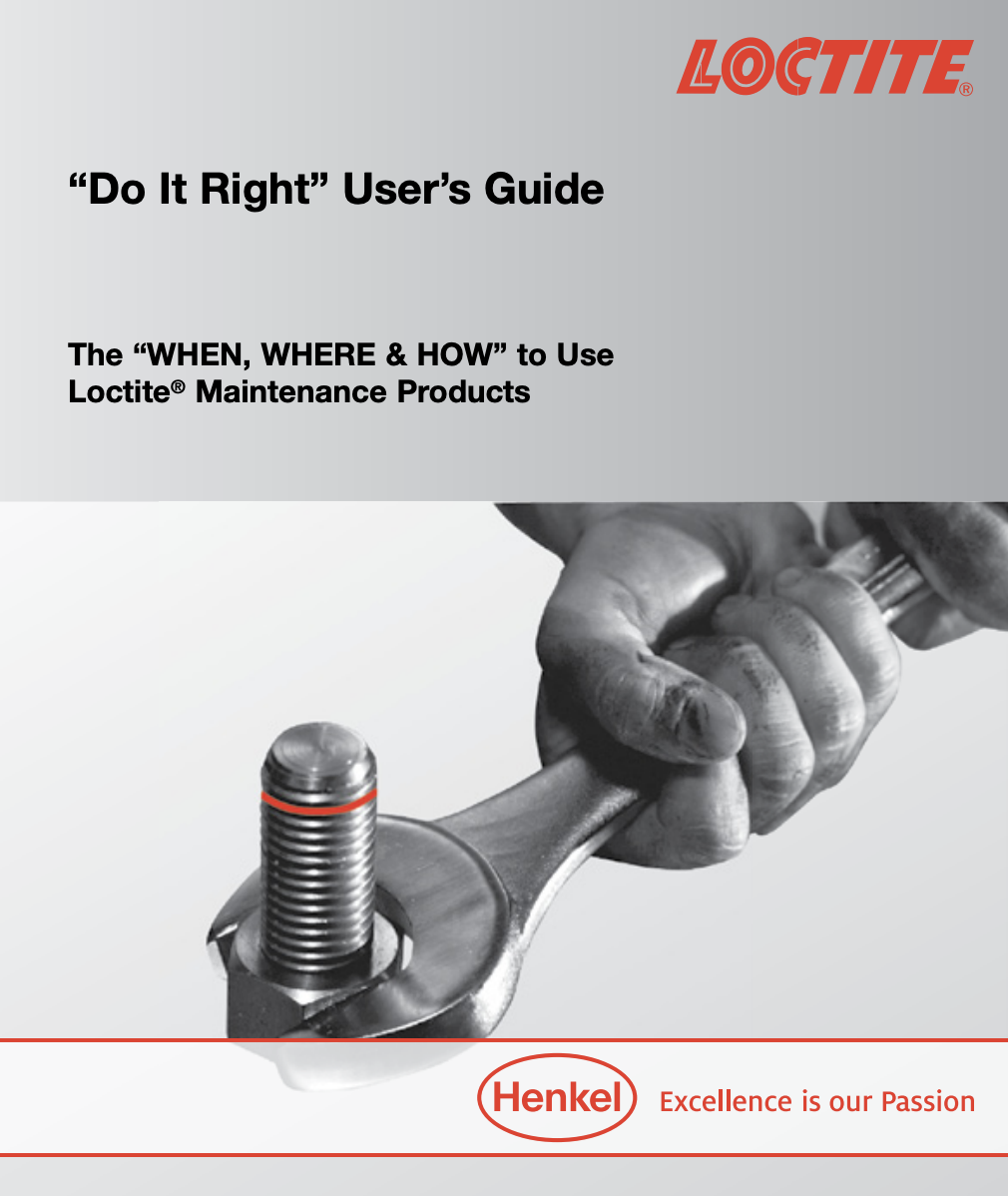
.png)
.png)
